Part 9 - Hiroshima, Japan

Part 9 - Hiroshima
We had been waiting for this day with mixed feelings. Obviously, everybody knows Hiroshima and its sad cause of fame only too well. Not least thanks to the guest speaker on board had we learned a lot about its historical background over the past few days. Therefore, Hiroshima was a destination raising many thoughts and questions.
How do you visit a place whose attraction is the fact that within a few seconds some 65,000 people lost their lives, some 70,000 people were injured and hundreds of thousands of people died or suffered permanently as a result of this event? In the blink of an eye entire families were wiped out and a city was virtually erased. What kind of feelings do you have if you find yourself at the very spot of which you have seen pictures of a mushroom cloud and inconceivable destruction countless times before?
Even though I had no answers to these questions, one thing was certain: I wanted to know! Although it certainly wouldn’t be with the same ease of our other explorations, I wanted to know how this was dealt with today and also gather experience and learn from it.
Maybe the others from our little group felt the same way, we hadn’t talked about it. But since we knew each other from our Osaka tour, Birgit and I knew that it would be a good mix of open-minded people that was greeted in port by TripleLight’s guide Hideo.
Hideo walked us to a station from where we took the JR train into town. On our way to the tracks we noticed a dozen railway employees in the hall of the station. Judging by their different clothes, they probably had different functions. Today they all stood in a line and thanked the passing customers with a bowing “Arigatou”.
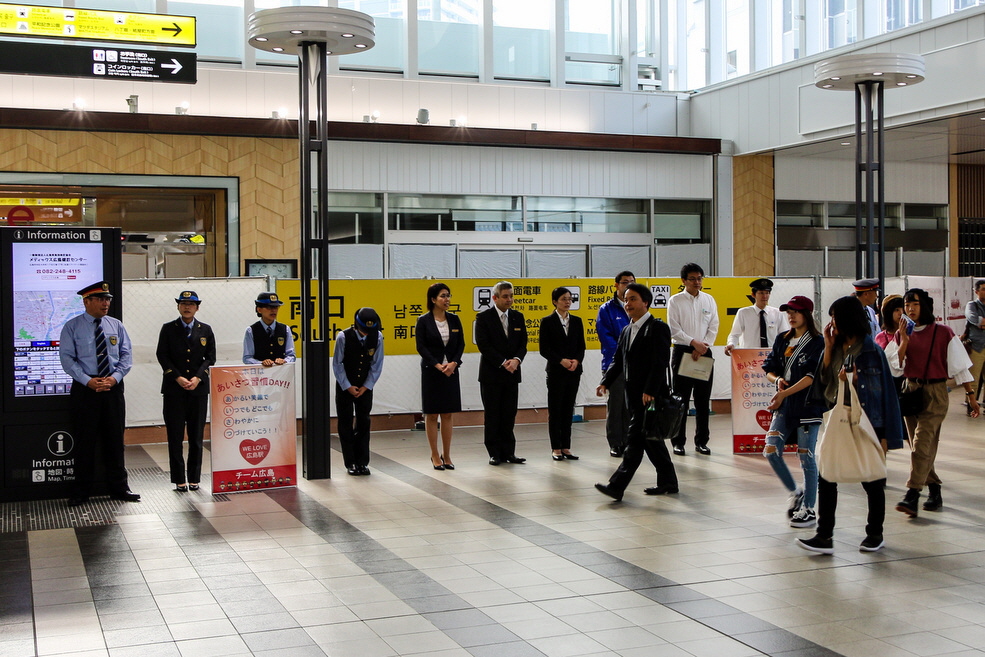
From Hiroshima station we took a tram which quickly took us to our first destination, the so-called Peace Park.
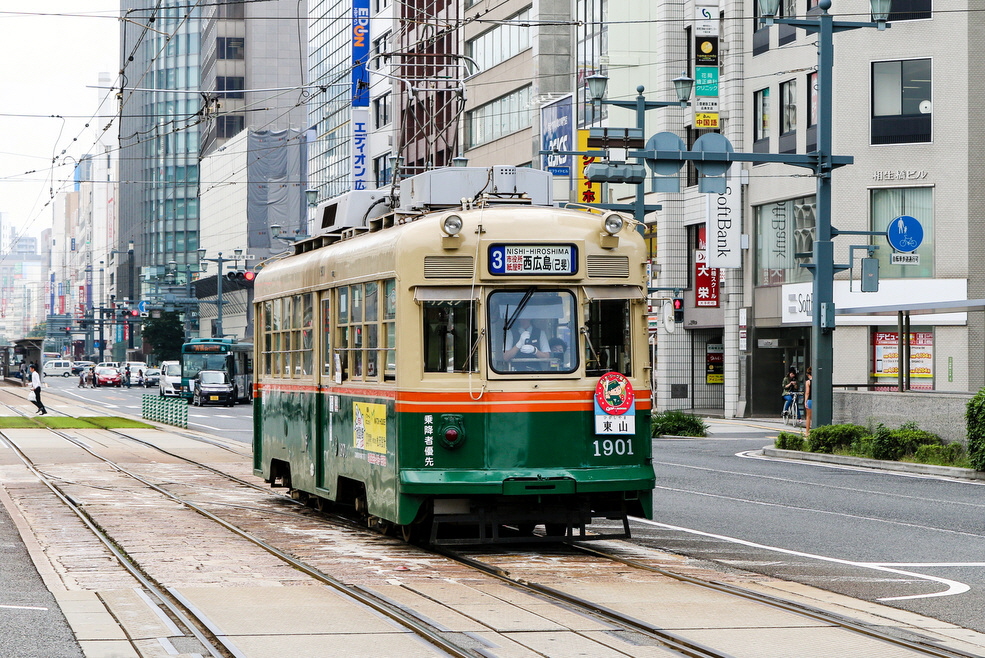
The park is located in the middle of Nakajima district. Before 1945, it represented the political and commercial heart of Hiroshima, which is why it was chosen as a target area. Today, this area hosts over 60 monuments, statues and commemorative stones.
We reached the perhaps most prominent monument, known as the A-Bomb Dome, after just a few meters on foot.
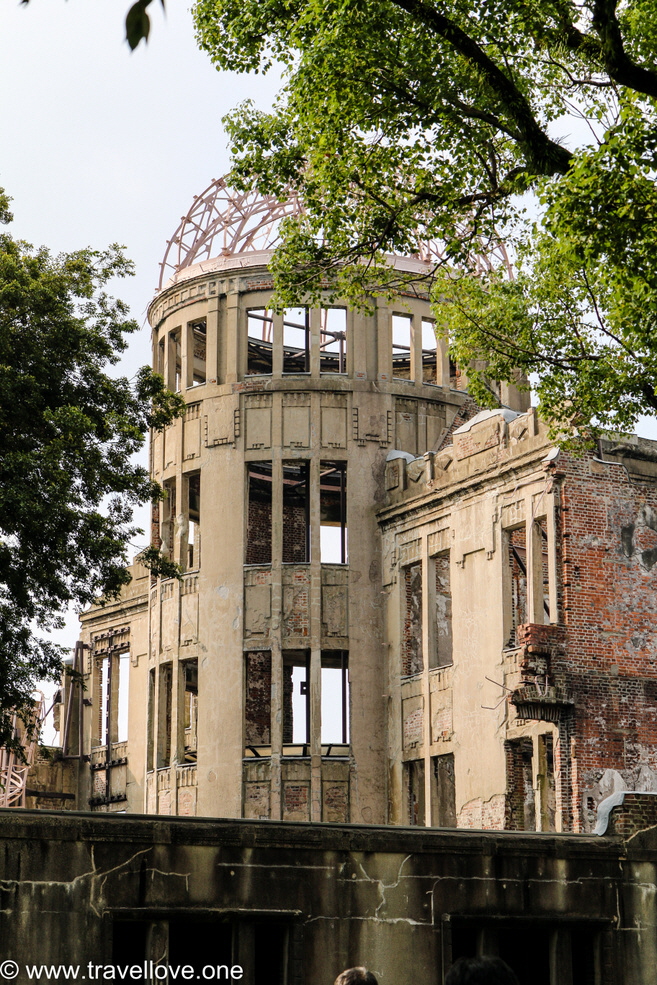
At 8.15 am on 6 August 1945, when the American B29 bomber „Enola Gay“ carried out the world’s first nuclear strike, the former building of the Chamber of Industry and Commerce dating back to 1914 mostly remained in place despite the short distance from the hypocenter of only 160 m (525 ft.).
Since the bomb, innocently named „Little Boy“, exploded about 600 m (1,970 ft.) above the ground, the blast caused by the explosion was almost perpendicular to the structure and many walls remained in place. In 1996, the ruin was added to the list of UNESCO World Heritage.
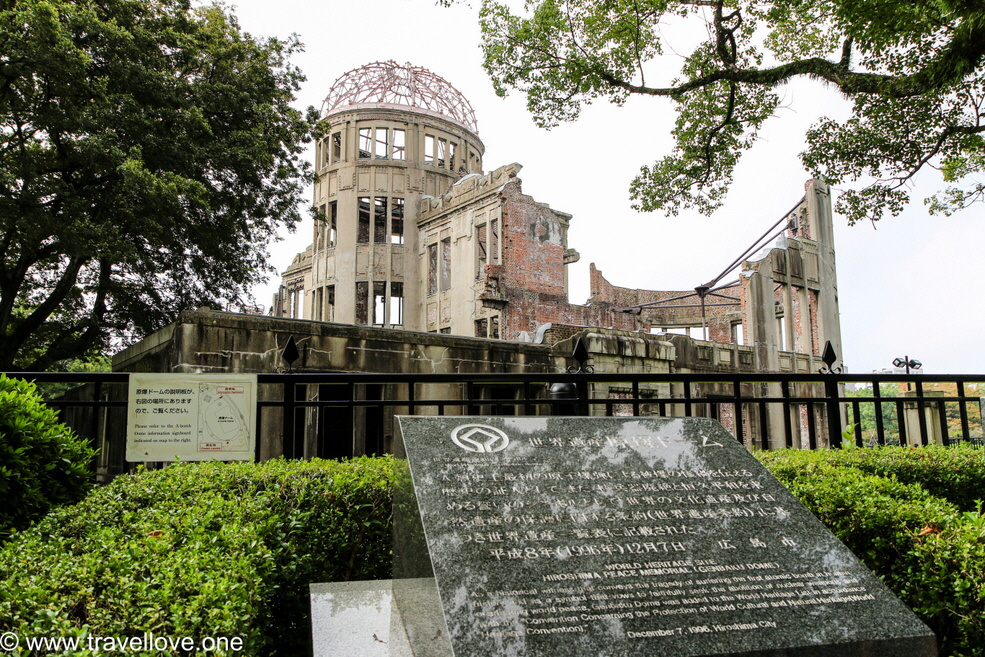
Not far away from the dome, a small monument with a lettered stone was erected. The inscription means “Irei”, comfort to the souls of the departed. It is dedicated to the employees of the lumber control.
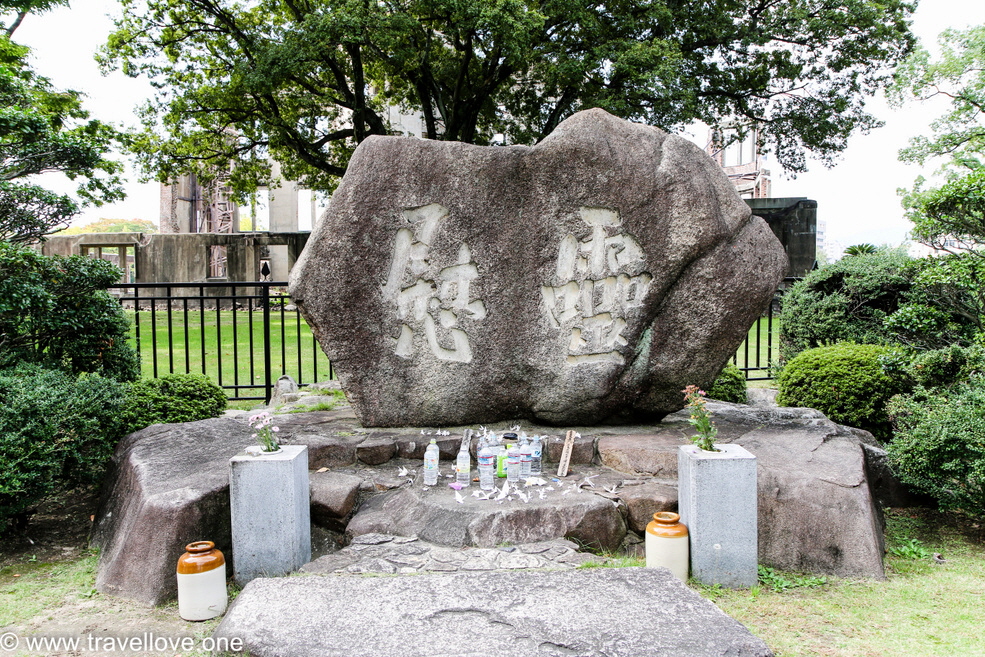
Filled water bottles had been left here, as we should also find in other places of remembrance. They are meant to comfort the souls of the victims who complained of unquenchable thirst due to the heat and the radiation wounds.
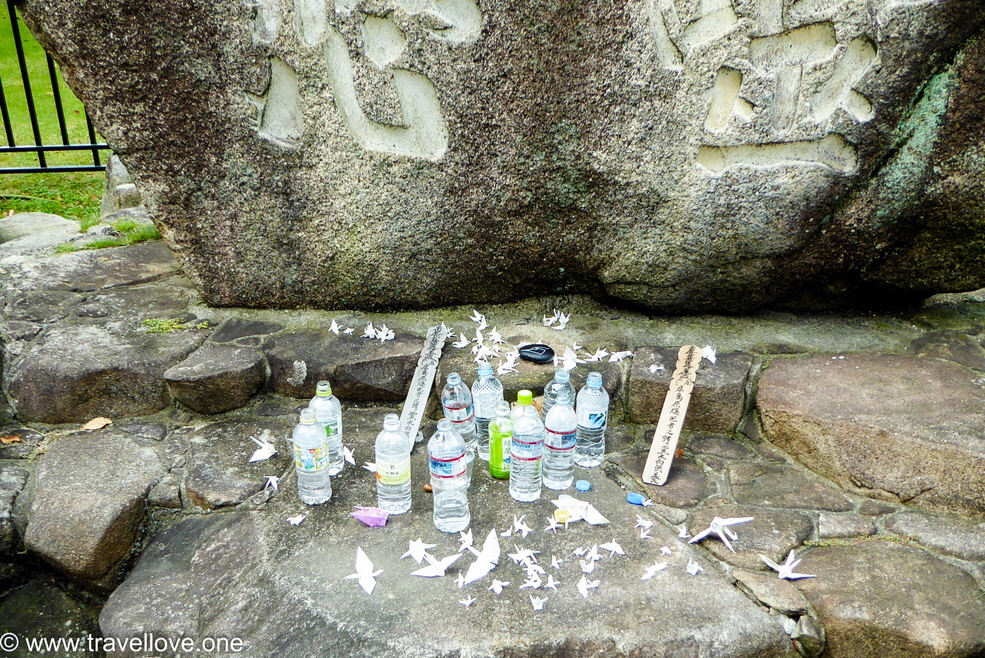
From here we could see the Peace Clock Tower on the other side of the Motoyasu River. The clock itself is located on a sphere 2 m in diameter (6.5 ft.) symbolizing the people of the world. It is held by three contorted steel beams representing the hands of the citizens of Hiroshima united in prayer for peace.
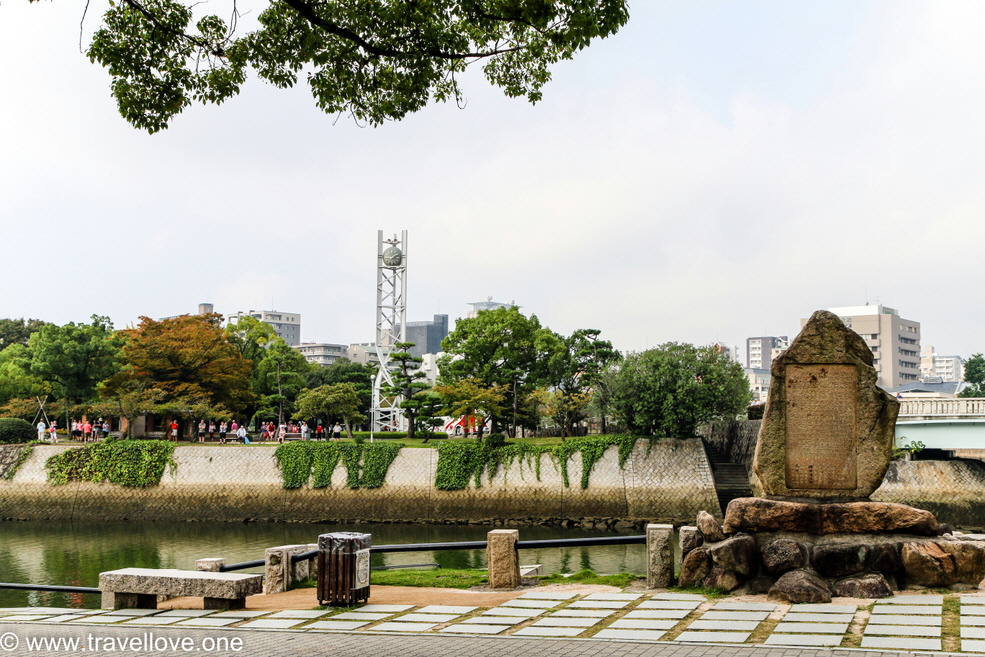
Further on we reached the memorial tower for mobilized students. To compensate for the shortage of labor, the government decided in 1944 that pupils and students should be employed in strategic industries such as ammunition factories. Of about 8,400 high-school students in Hiroshima, some 6,300 died on the day of the bombing. The tower was errected to commemorate them.
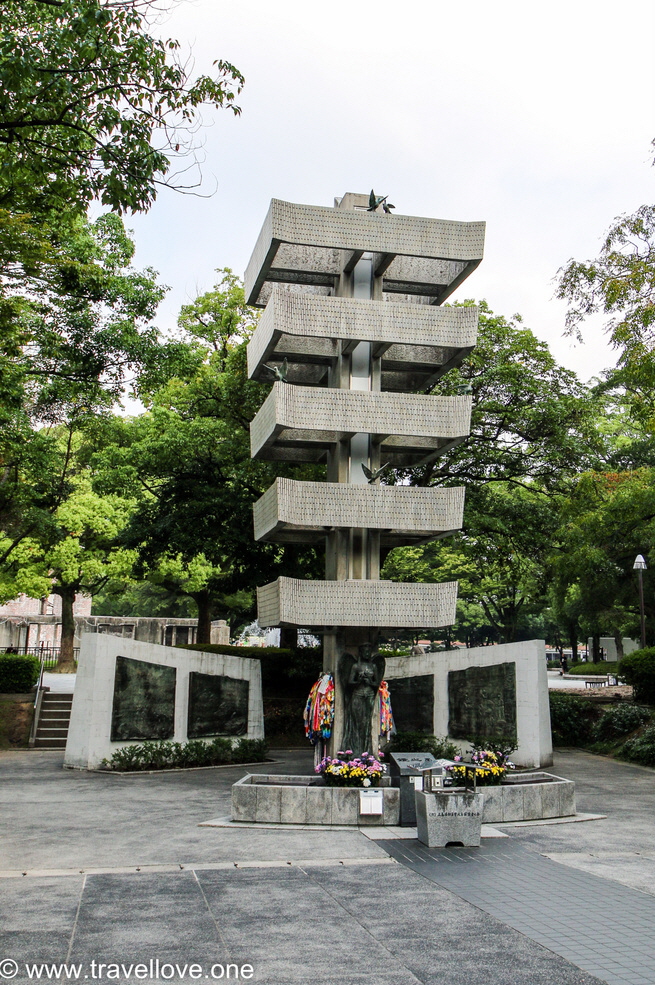
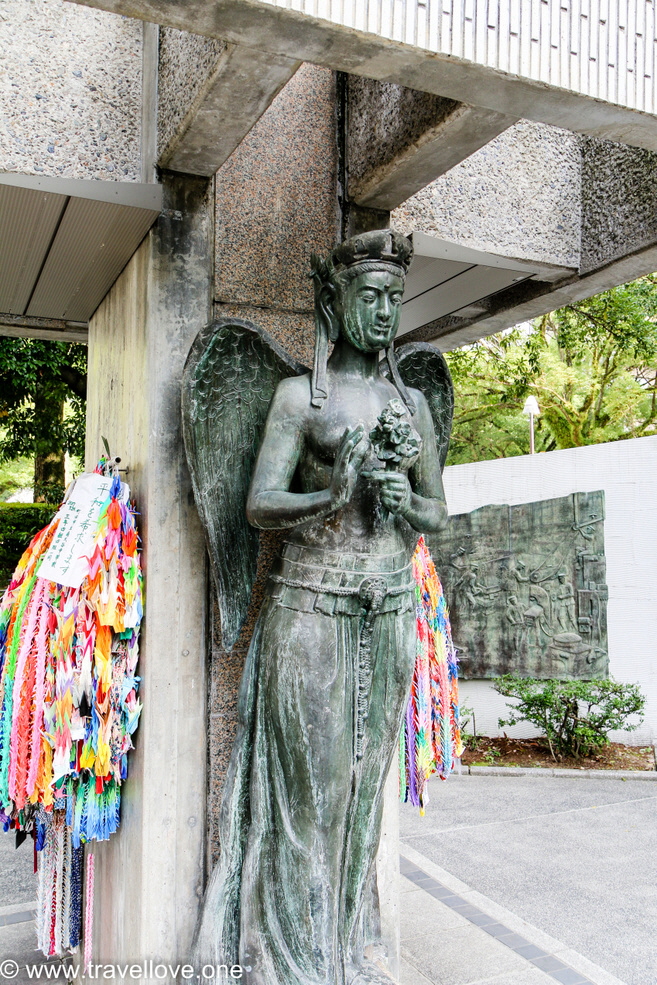
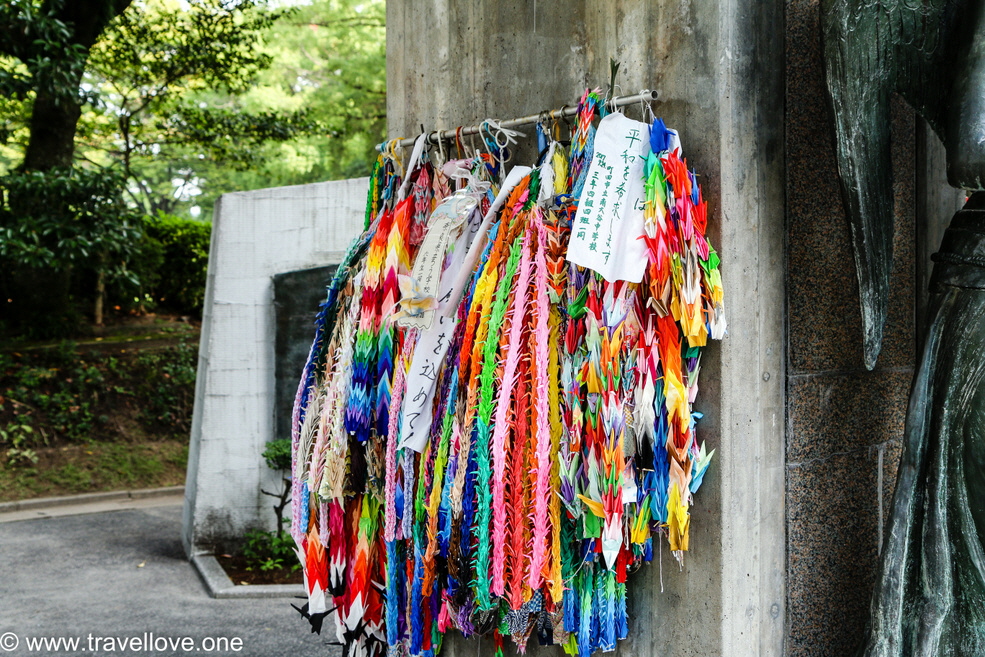
In a side street, Hideo took us a very inconspicuous place which was only marked by a plate. This was Ground Zero, so to speak, the hypocenter of the bomb blast. At 8.15 am more than 70 years ago, this is from where the ring-shaped shockwave spread and could still be felt 40 km (25 miles) away.
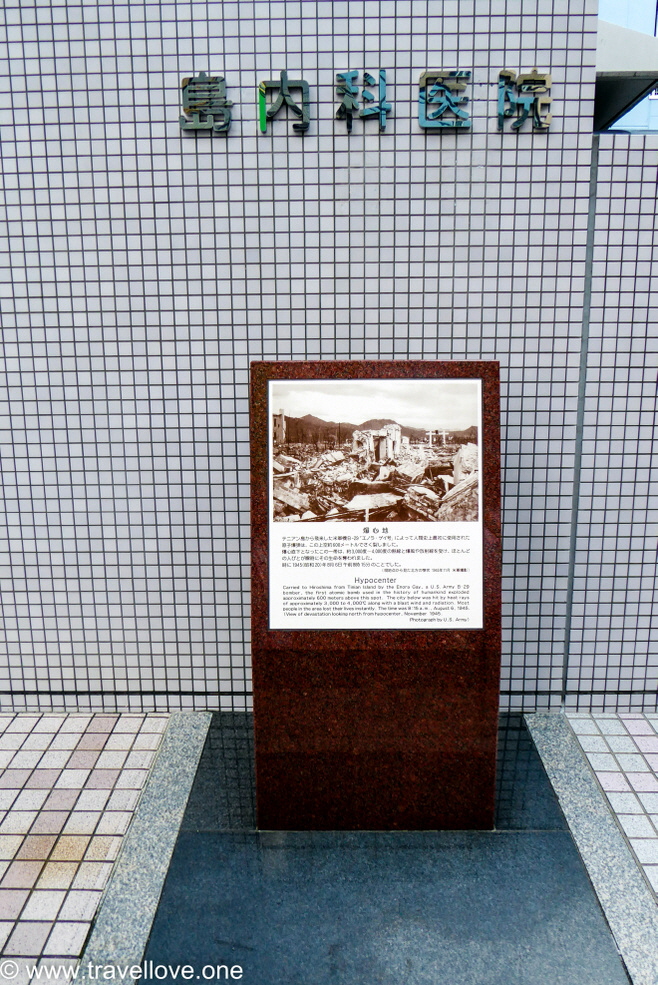
Within a radius of 1 km (0.6 miles) 90 percent of the people died either immediately or soon after. For about one second, the temperature at the hypocenter was about 3,000 - 4,000 degrees Celsius (5,432 – 7,232 Fahrenheit). Everything evaporated here, even metal. People who were in the center of the explosion burned completely. All that was left of them was, in some cases, a shadow on a remaining wall which their body had shielded from the heat radiation for the fraction of a second. An unfathomable and horrific thought.
We crossed a bridge across the Motoyasu River towards the Children’s Peace Monument.
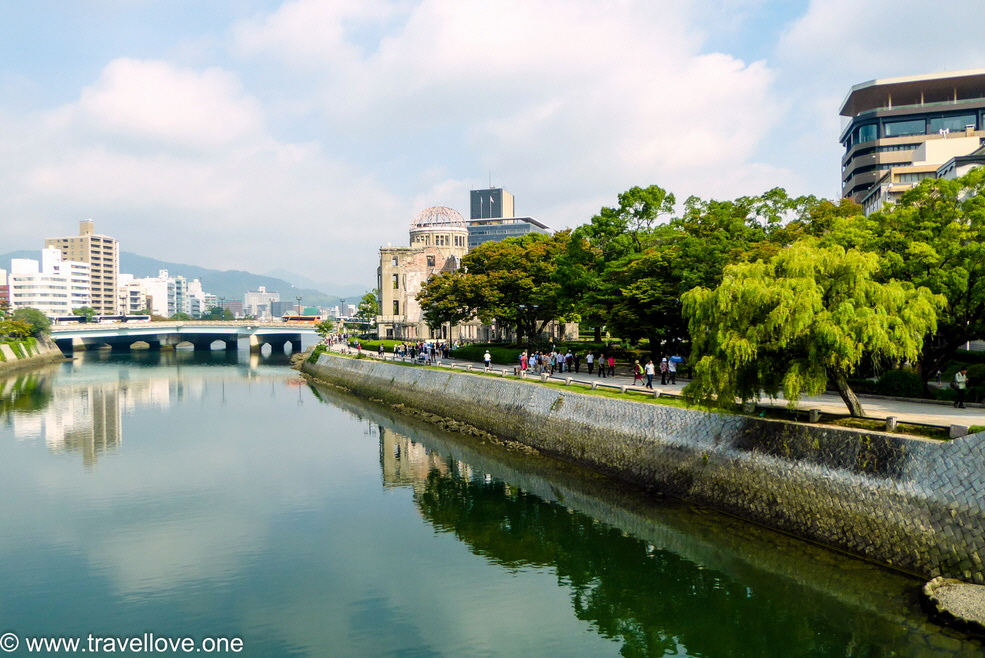
The monument was built in 1958 and dedicated to the girl Sadako Sasaki. She became known around the world for folding hundreds of cranes (Orizuru). She inspired the statue of a girl on top of the three-legged dome holding an origami crane high in the air.
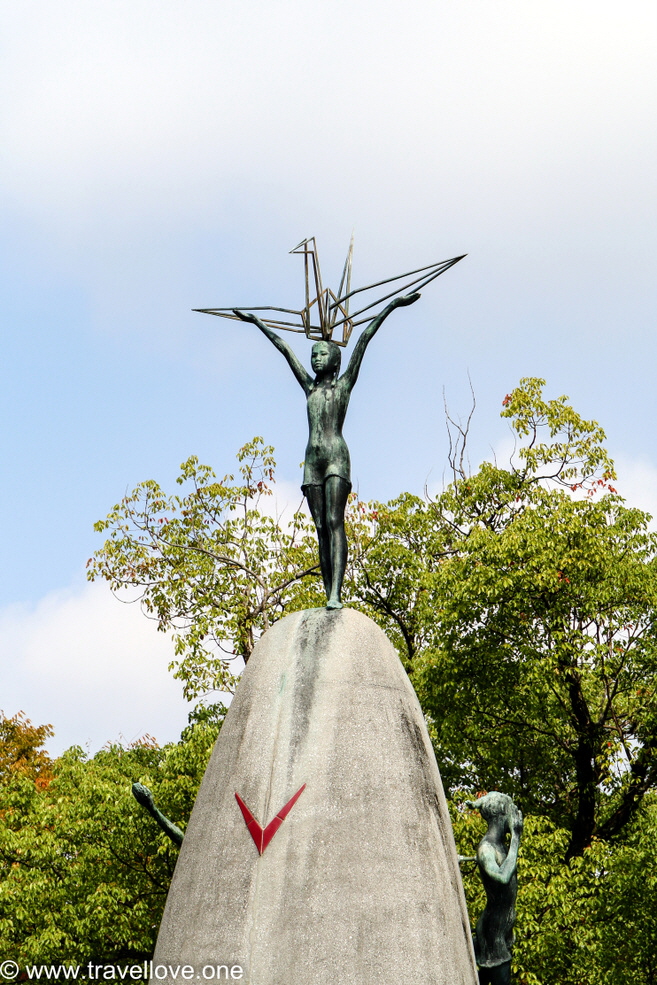
Sadako’s story is heartbreaking. Sadako was born in Hiroshima in 1943, in the middle of World War II. When the bomb dropped in August of 1945, the little girl was lucky, she survived.
Shortly after, the war ended. Sadako grew up and went to school. She loved singing and ran faster than anybody else in her class. But Sadako’s luck shouldn’t last. Nine years after surviving the nuclear bomb, the girl fell ill with leukemia, blood cancer. The bomb she had survived as a toddler was to kill her after all.
Sadako is only one of many children who lost their lives because of the nuclear bomb. But the reason why many people around the world remember her in particular has to do with the bird that the bronze Sadako holds with outstretched arms into the sky. According to Japanese legend, the gods grant a wish to those who fold 1,000 paper cranes. So Sadako began to fold, one bird after another, even though she became weaker and weaker and had already folded more than 1,000 cranes. Into every crane she folded her biggest wish: “Let me get well!”. The wish shouldn’t come true. Sadako died on 25 October 1955. She was 12 years old.
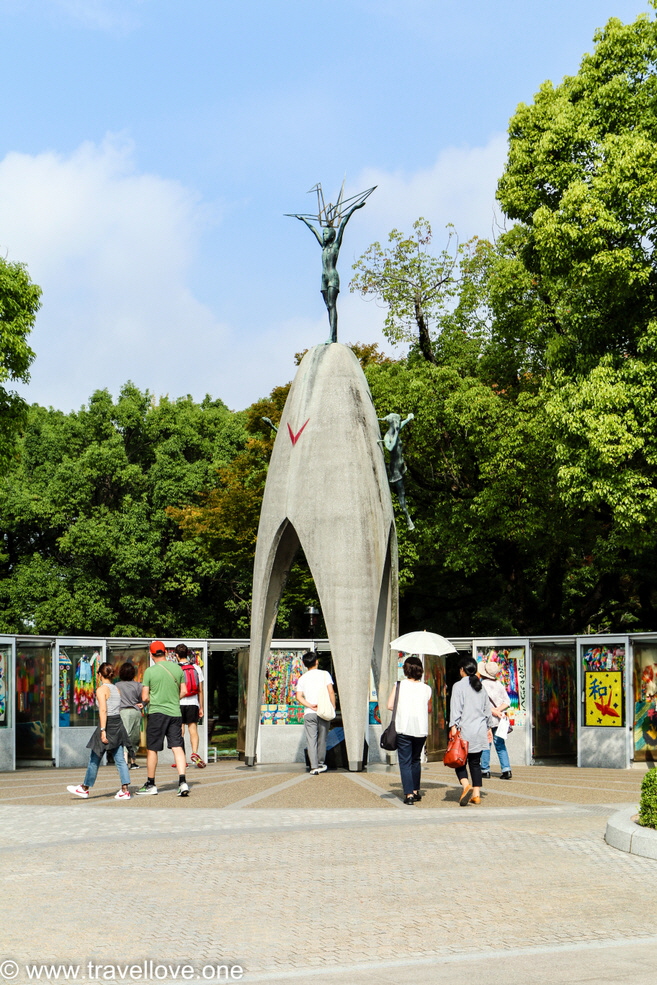
The monument is surrounded by show cases displaying thousands of paper cranes folded by children from all around the world as a symbol of the peace movement and the resistance to nuclear war. At the base of the monument there is a black marble slab with the inscription: “This is our cry. This is our prayer. For building peace in the world”
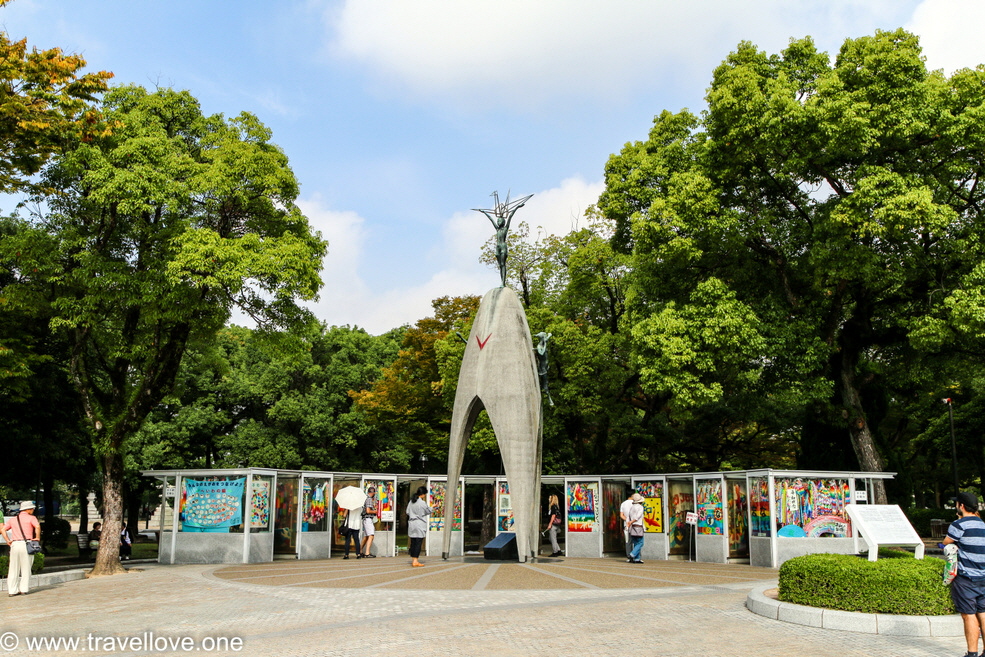
The monument was also our entrance to a park into which Hideo led us. Already on our way there, we heard a gong-like sound every now and again. The sound originated from the peace bell which stood in a pond filled with lotus flowers.
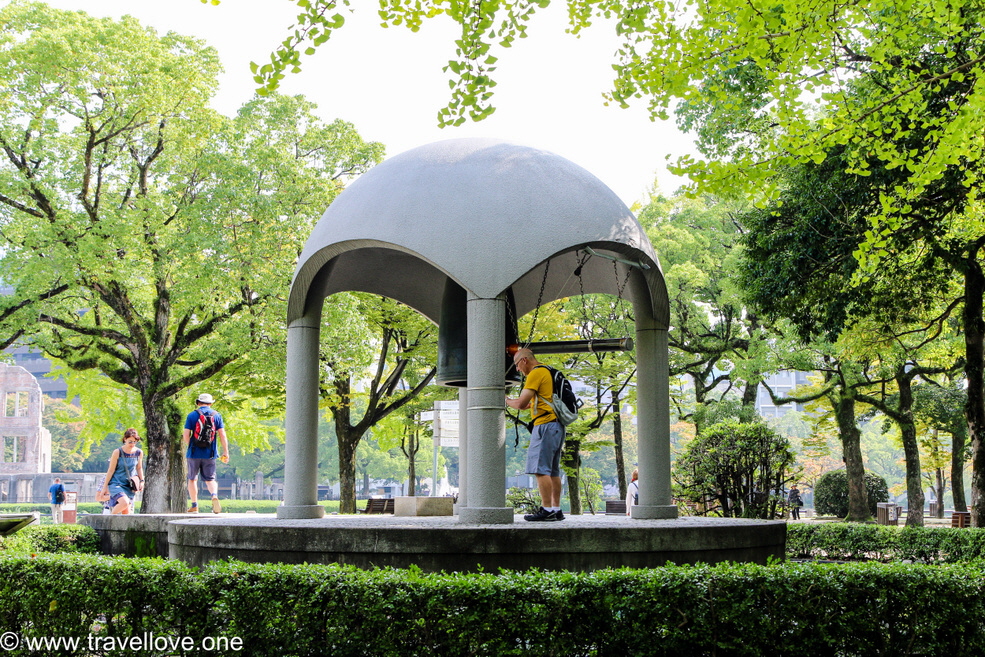
The surface of the bell shows the relief of a world without borders and the words “The world is one”. With the desire to ban all nuclear and hydrogen bombs, the impact area of the mallet bears the symbol of nuclear energy, embedded on the back is a mirror reflecting the heart of the person ringing the bell.
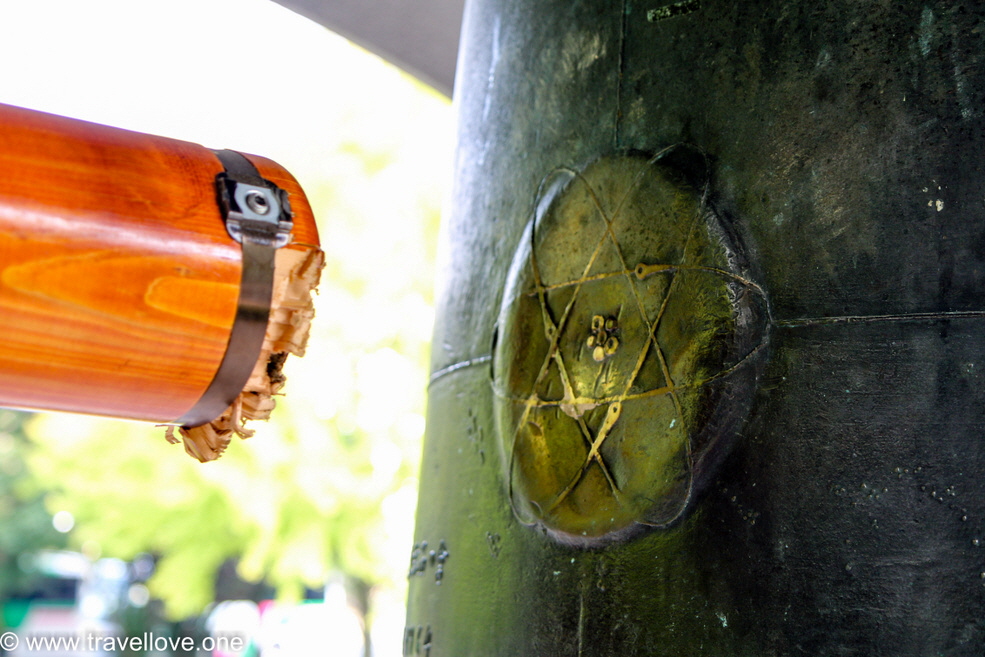
Not far away, Hideo showed us a memorial mound. A round, dome-shaped hill, built in the style of an imperial tomb from the Momoyama period. The memorial mound marks the spot where innumerable salvaged victims of the nuclear bomb were cremated. Almost casually, Hideo explained that there was a chamber beneath the hill containing the ashes of some 70,000 unknown victims.
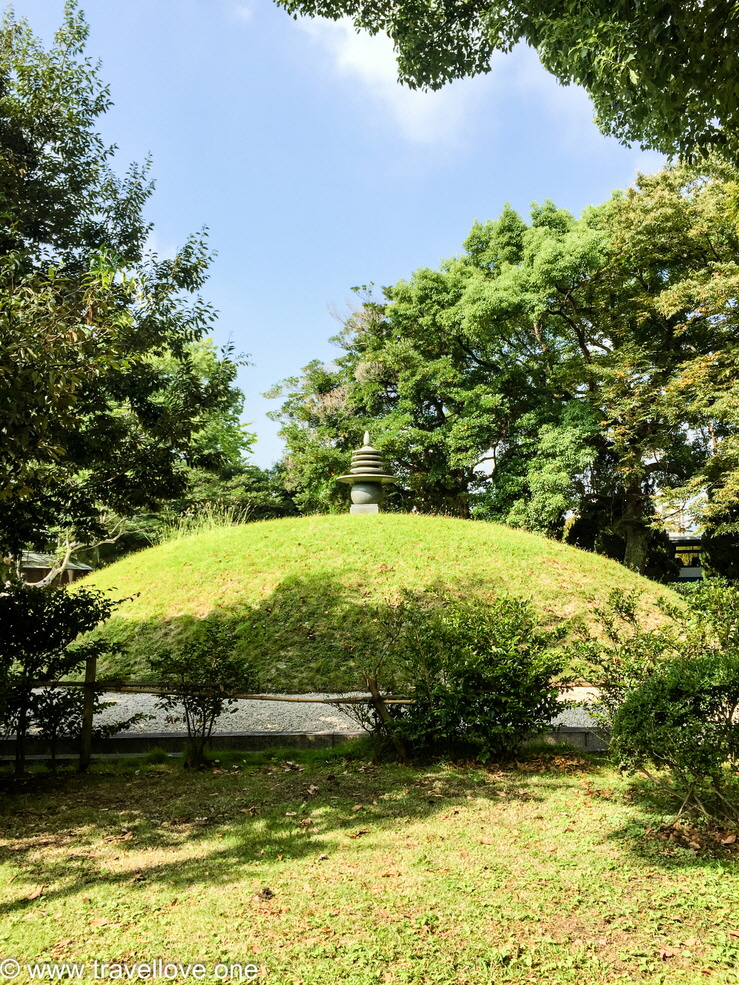
This unimaginable number mentioned so casually somehow only sank in on our way to the next memorial nearby.
A column towering over the body of a turtle commemorated the approximately 20,000 Korean victims of the nuclear bombing.
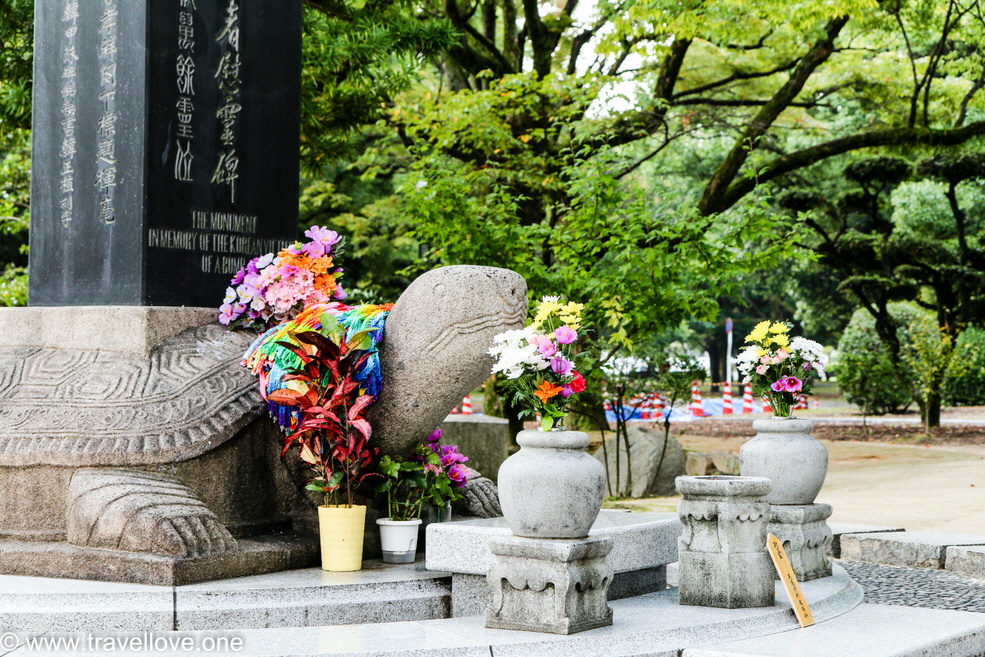
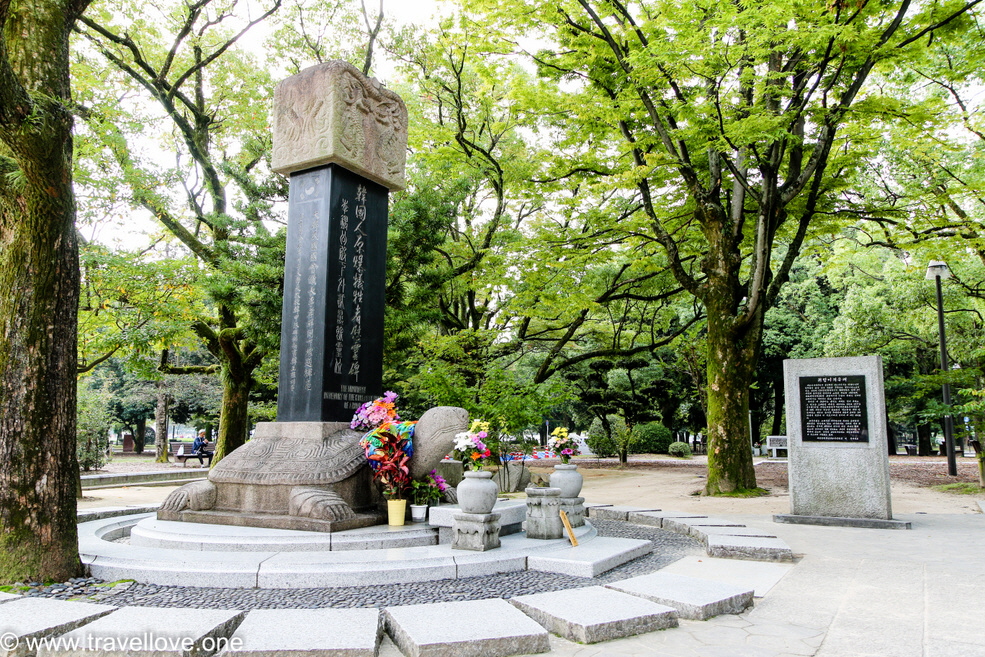
On our way to the Peace Museum we first reached The Flame of Peace. The structure represents two folded hands opening upwards like a goblet. In the middle burns an “eternal fire” that hasn’t gone out since 1 August 1964 and which is to burn until the day when all nuclear weapons have disappeared from the earth.
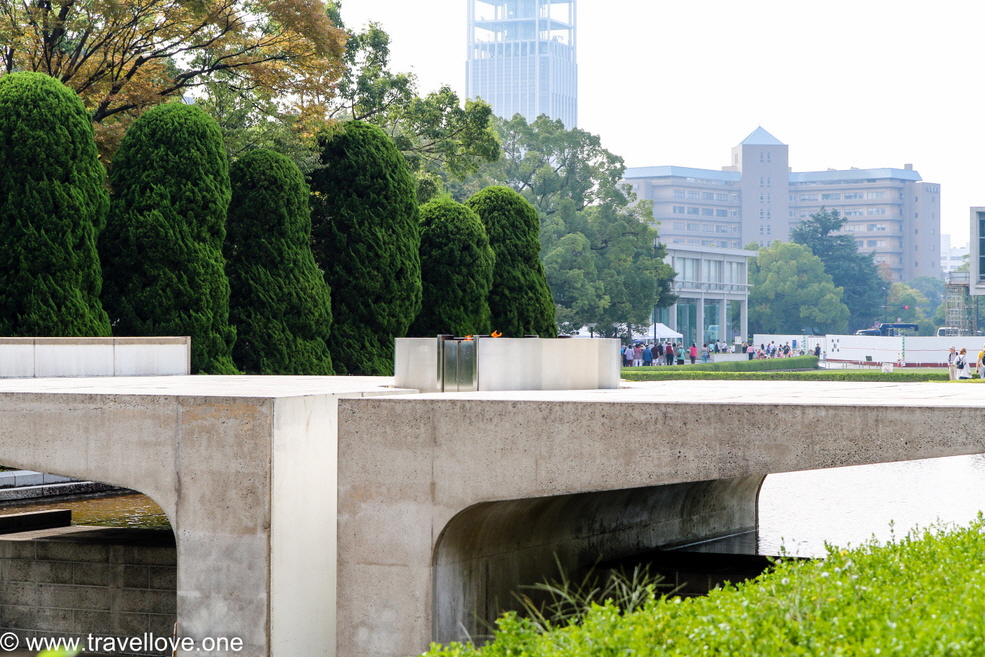
In 1952, the “Cenotaph for the victims of the atomic bomb” was erected in the middle of an open area in front of the museum.
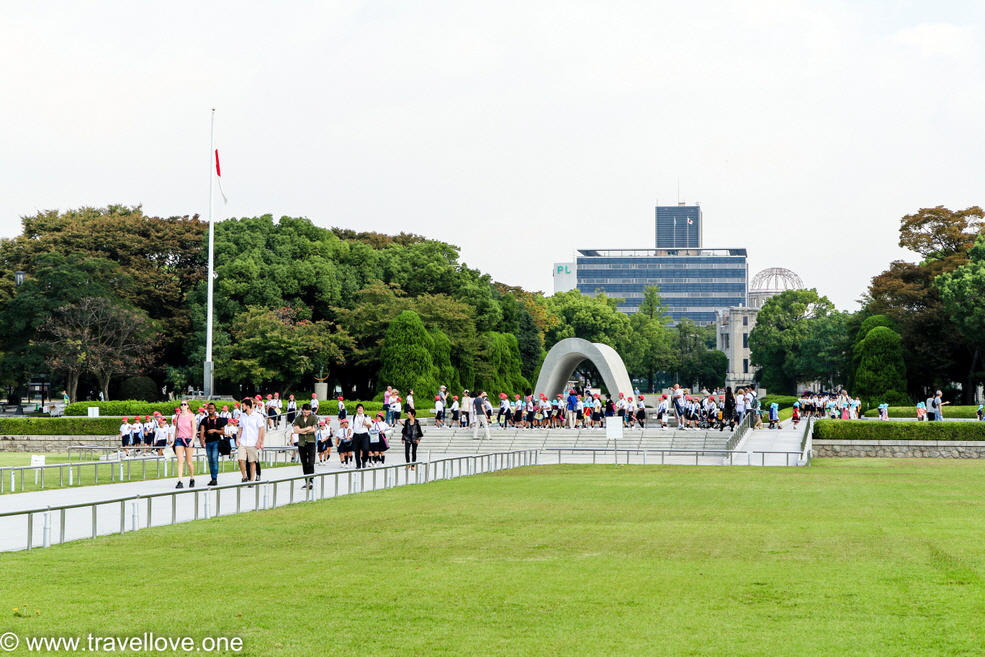
The stone cenotaph contains a list of victims of all nationalities. The list is constantly expanding, on 6 August 2010 it comprised 97 volumes with 269,446 names.
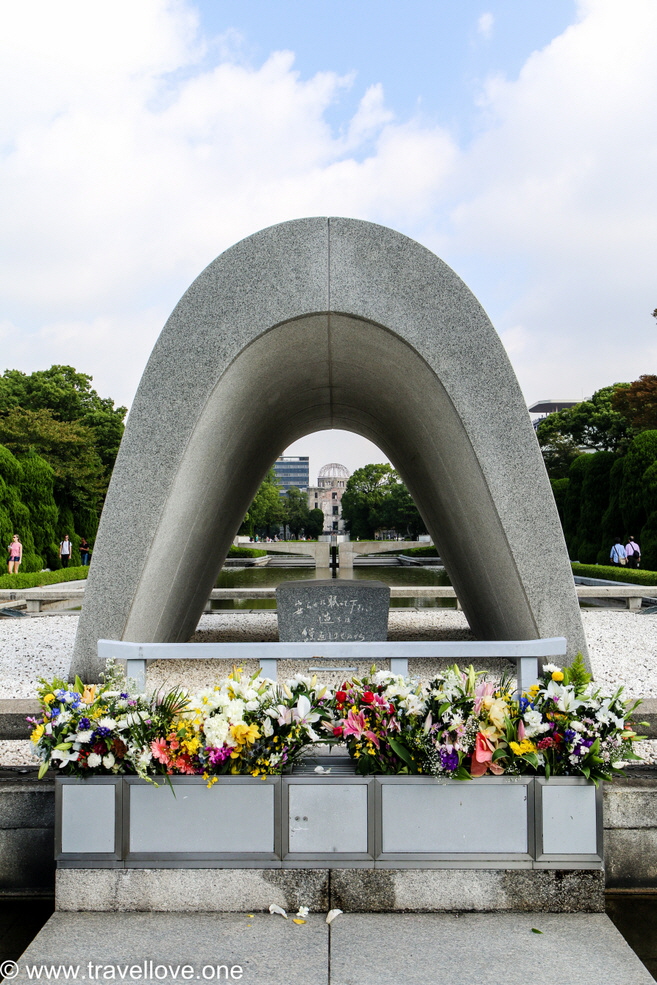
It is written on the stone, “Let all the souls here rest in peace, as we shall not repeat the evil”
Throughout the parks we saw school classes coming here with their teachers.
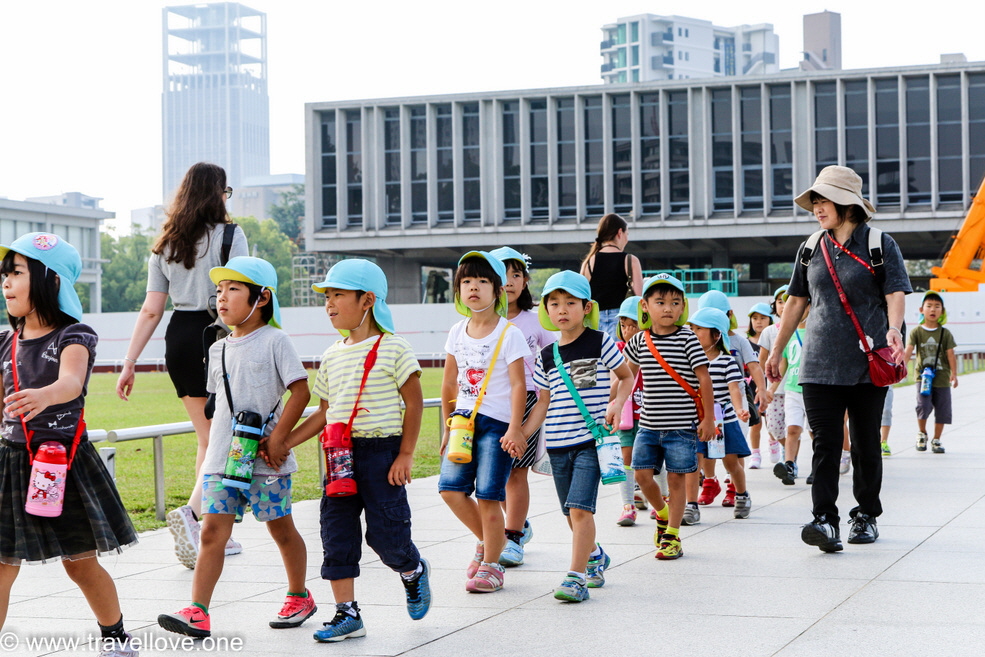
Now it was time to go to the Peace Museum. The aim of the museum is to convey the horror and inhumanity of nuclear weapons through exhibitions of photographs, explanations, survivors’ reports and collections of related material, and to spread the message “No more Hiroshimas”.
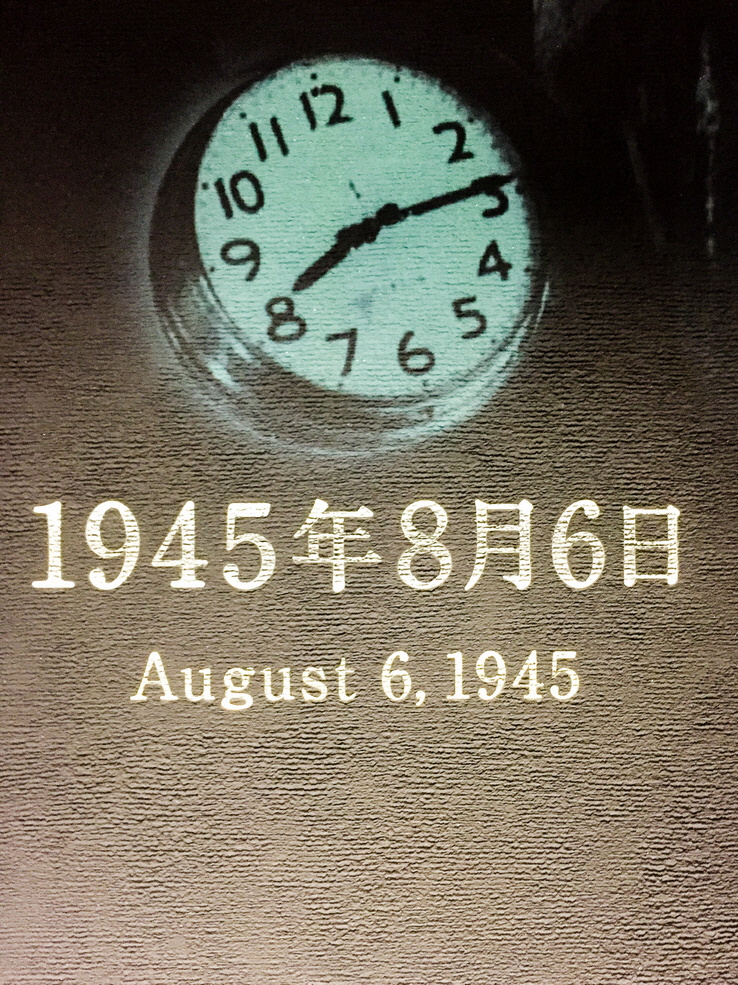
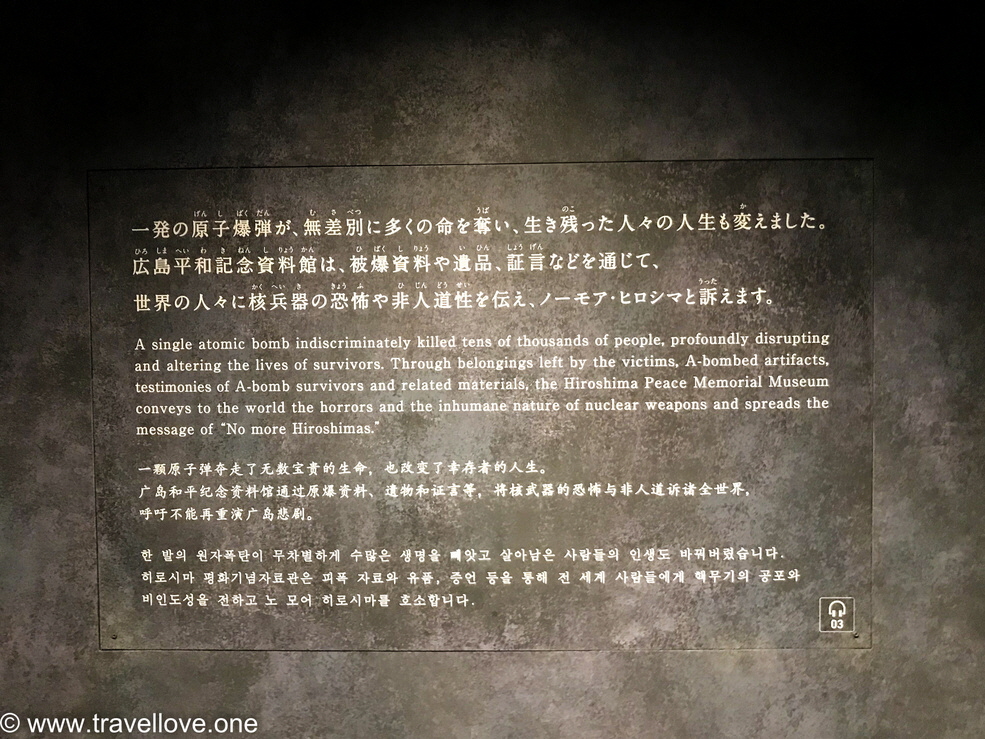
First we went through some corridors with huge photo walls, which gave us the impression of being in the environment of the time.
Before the bombing…
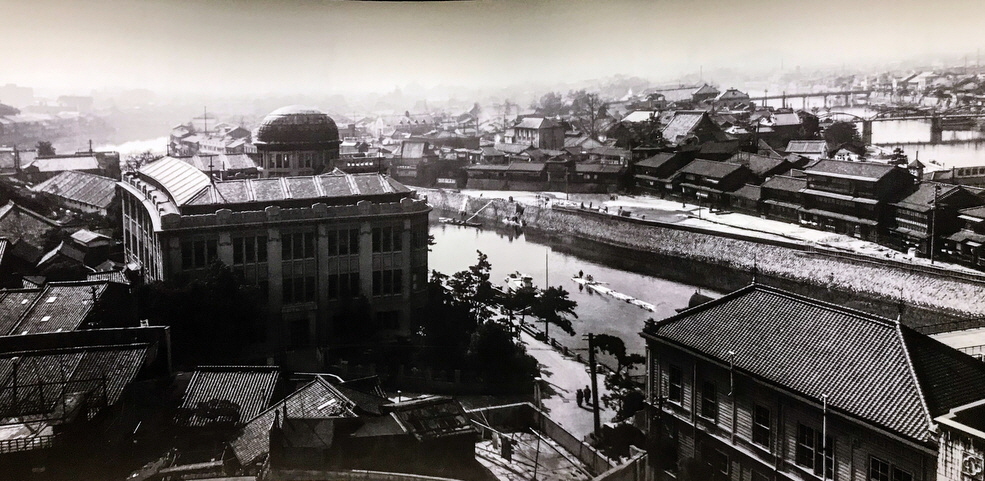
and after…
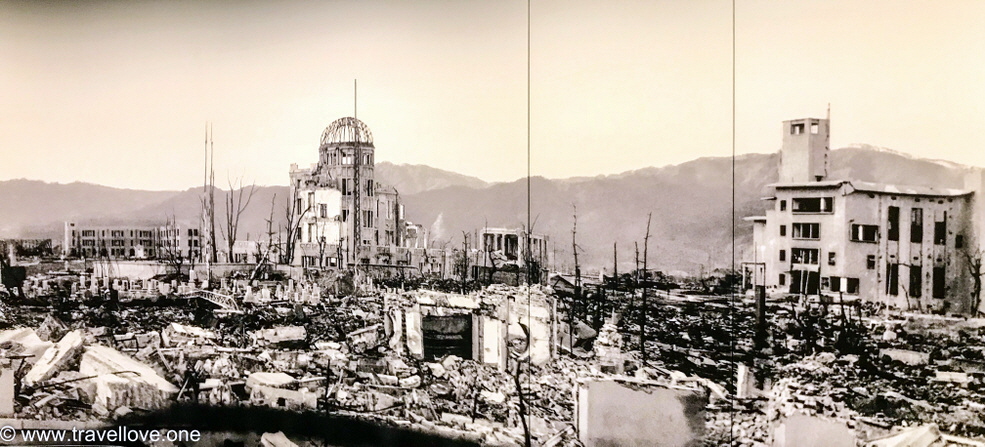
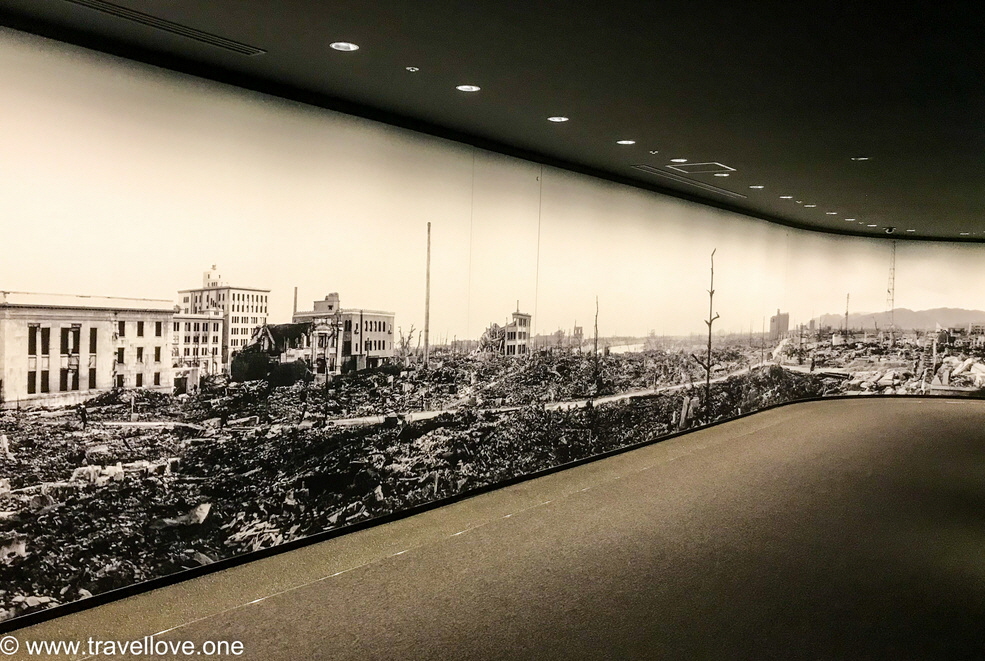
In another room, a simulation of the bomb drop and its consequences was shown on a central table:
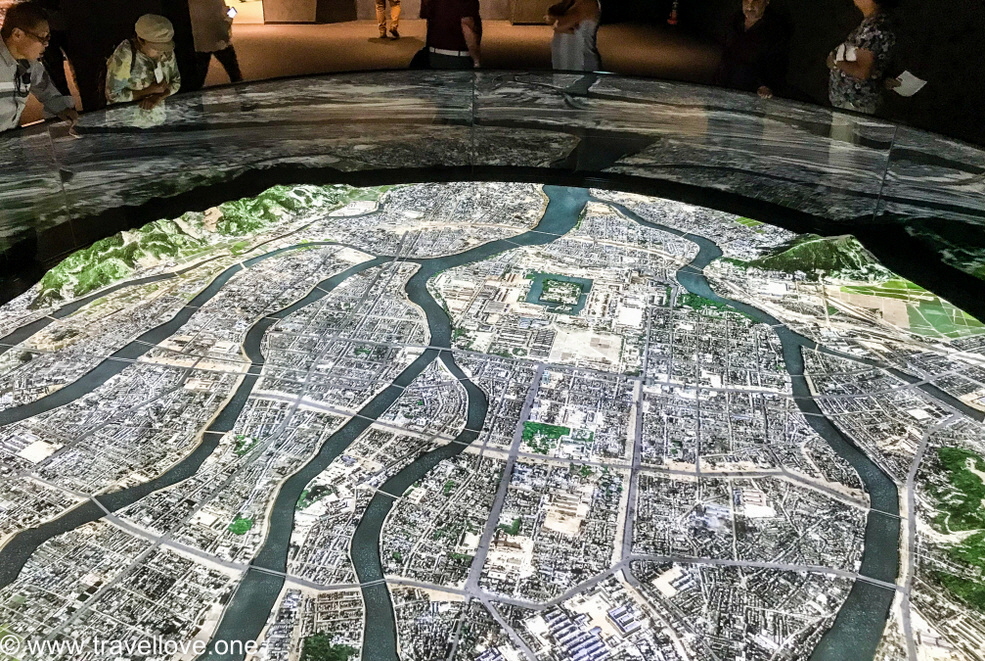
In the following rooms, photographs and tables were used to show the consequences of the explosion in relation to the distance from the hypocenter. Many of the photos of disfigured corpses and wounded victims, who had to endure unimaginable suffering with ghastly burns and radiation wounds in field hospitals, were extremely brutal and disturbing.
Some plates recounted reports of survivors who despite the severest burns had dragged themselves in a trance-like state through the hellish heat of the burning ruins. People stumbled over bodies that were so disfigured that it was impossible to tell if they were possibly father, mother or children. Reading the plates was difficult and moving. I don’t think any visitor was able to do it with dry eyes.
I won’t show most of the pictures because of their atrocity. However, the exhibition in the context of the museum was right and certainly necessary for visitors to visualize the cruel and inhuman reality.
For example, this comparatively harmless photo shows that even many kilometers away, the shockwave was able to burn the patterns of people’s clothes, here a kimono, into their skins.
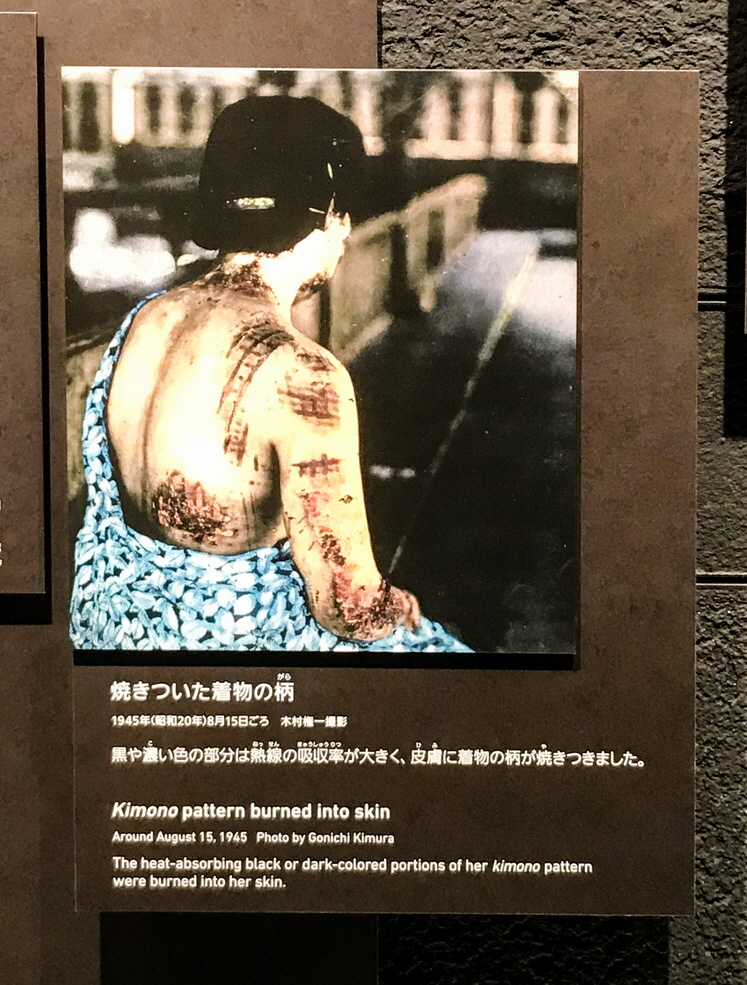
The last hall featured exhibits of findings and statements of famous visitors projected on the wall.
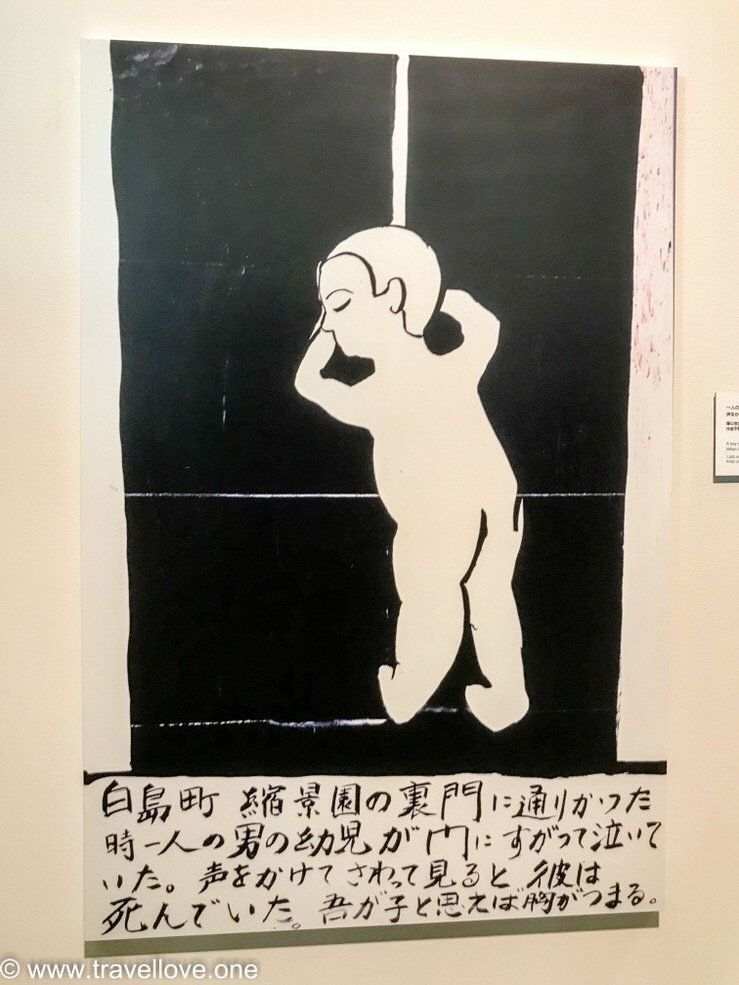
Translation of the caption: “A boy clinging to a gate seemed to be crying. When I called to him and touched him, I found out he was dead.”
(1,300 m (0.8 miles) away from the hypocenter)
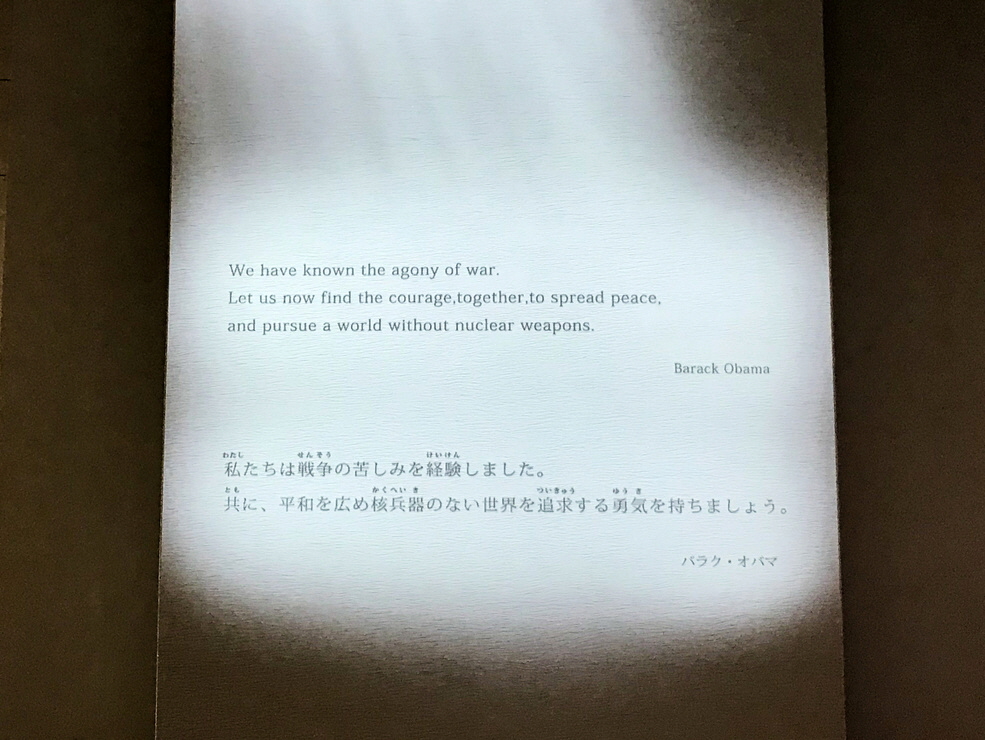
The many impressions at the memorials and in the museum were oppressive and almost overwhelming. When we exited the museum and met a group of little children, we all had lumps in our throats.
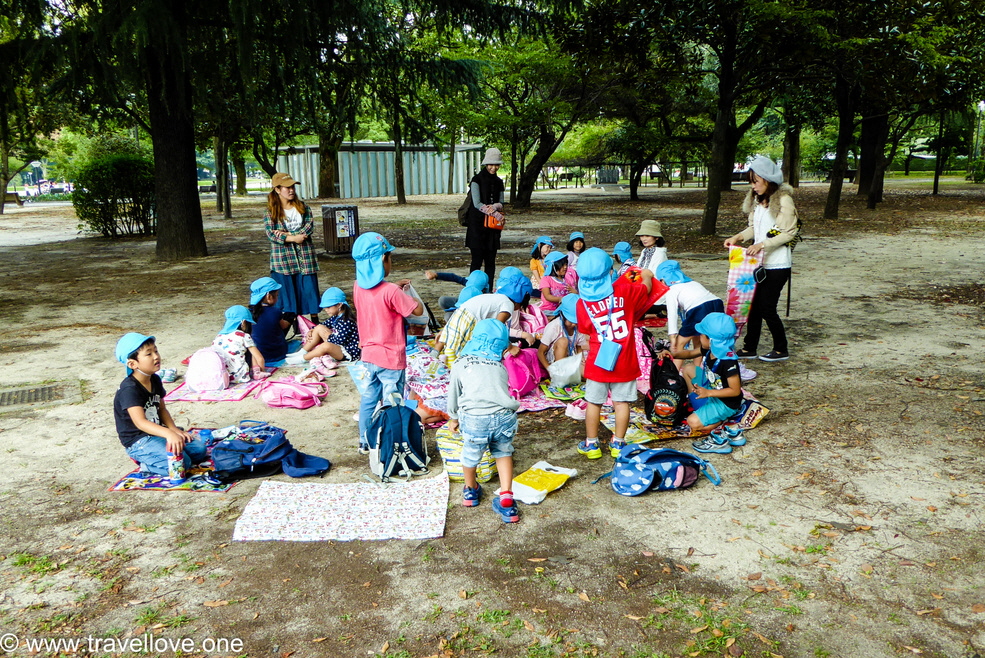
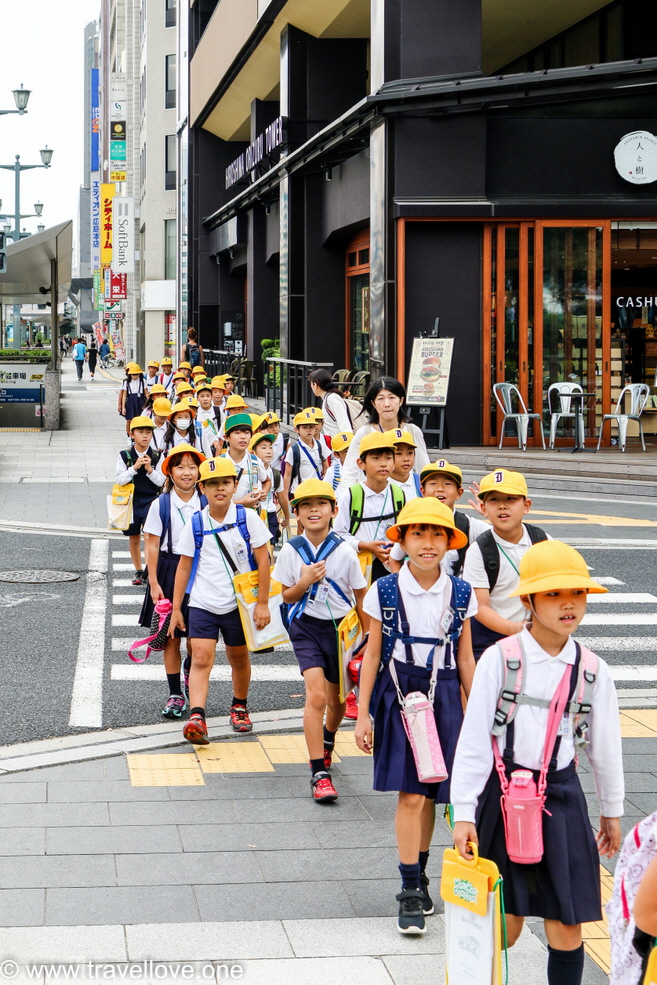
Judy and I talked about the children, and both of us were close to tears. Somehow, seeing the laughing children made me sad. We had come to this place at a time when political leaders threaten each other with the use of this horrable weapon again. Having just learned very poignantly what prototypes of these weapons were capable of more than 70 years ago, I wondered what kind of world we were leaving these children. Have we really learned nothing at all?
We took a tram to return to Hiroshima station. Since we hadn’t bought any tickets, I asked Hideo where we were supposed to pay. He simply replied we’d pay when we’d get off.
And indeed, in the middle of the platform, a railroad employee with a mobile cash register stood there waiting for the passengers to come to him. Frank and I gave each other a puzzled look and probably had the same thought. In our countries back home you couldn’t just rely on the passengers’ honesty like this.
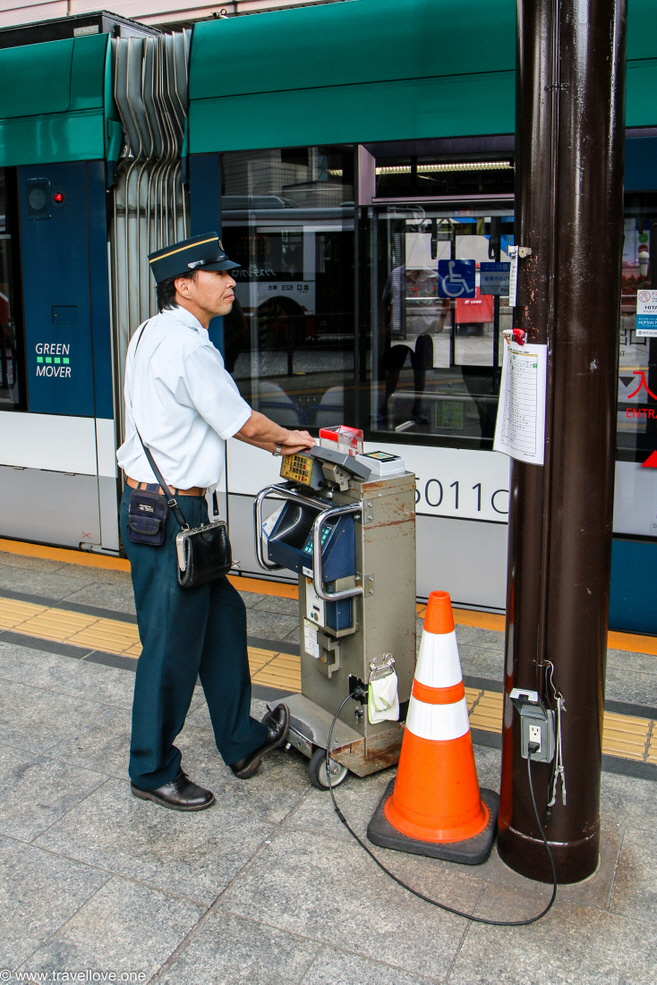
From here we took a JR regional train to Miyajimaguchi, from where Hideo took us to a ferry terminal and then we took the ferry to Miyajima Island.
From the deck of the ferry we could see numerous oyster farms as well as the landmark of the island in the distance – a large red torii which seemed to float on the water.
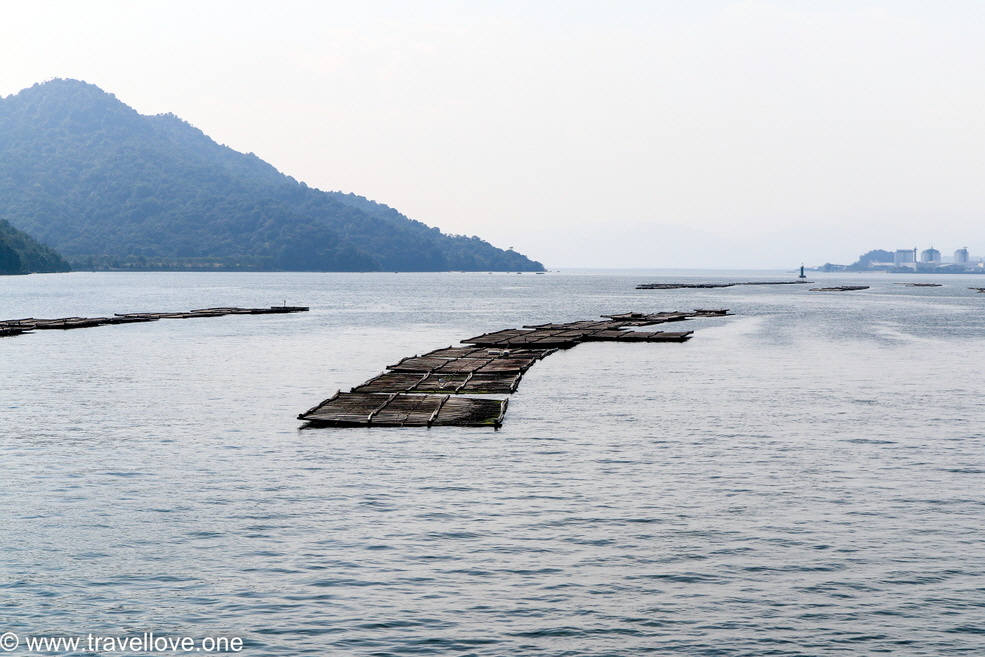
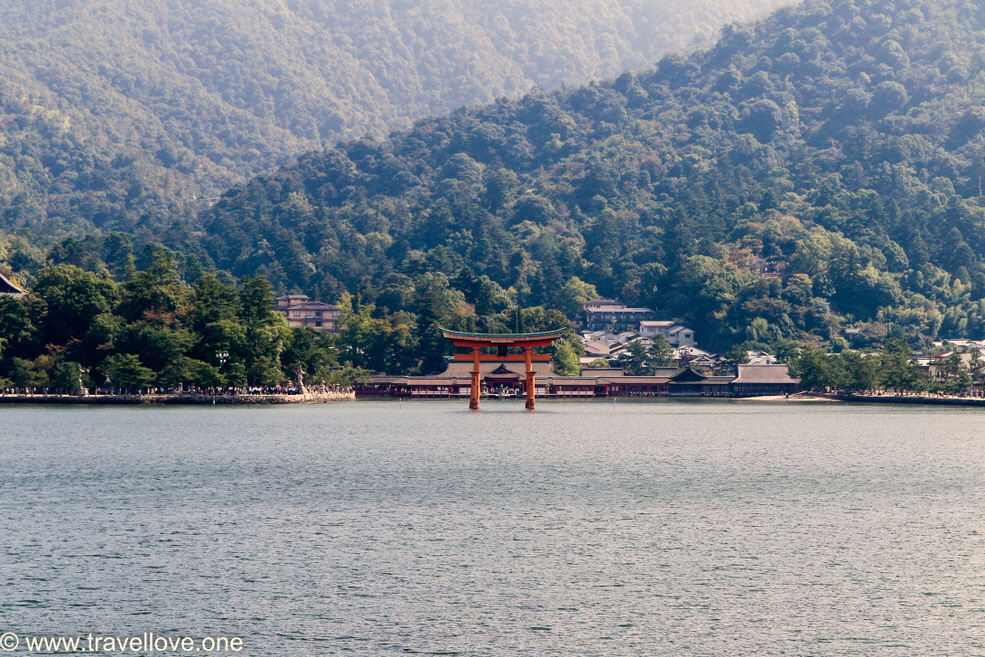
When we arrived at the ferry’s landing port, we were greeted by curious four-legged residents of the island. In the beginning we thought it was really sweet to look into those big, begging eyes of the tame deer. But the words “Sorry, I haven’t got anything for you!” didn’t have any effect on those cute little bambis. They vehemently insisted to see for themselves and poked into every pocket and nudged at every camera.
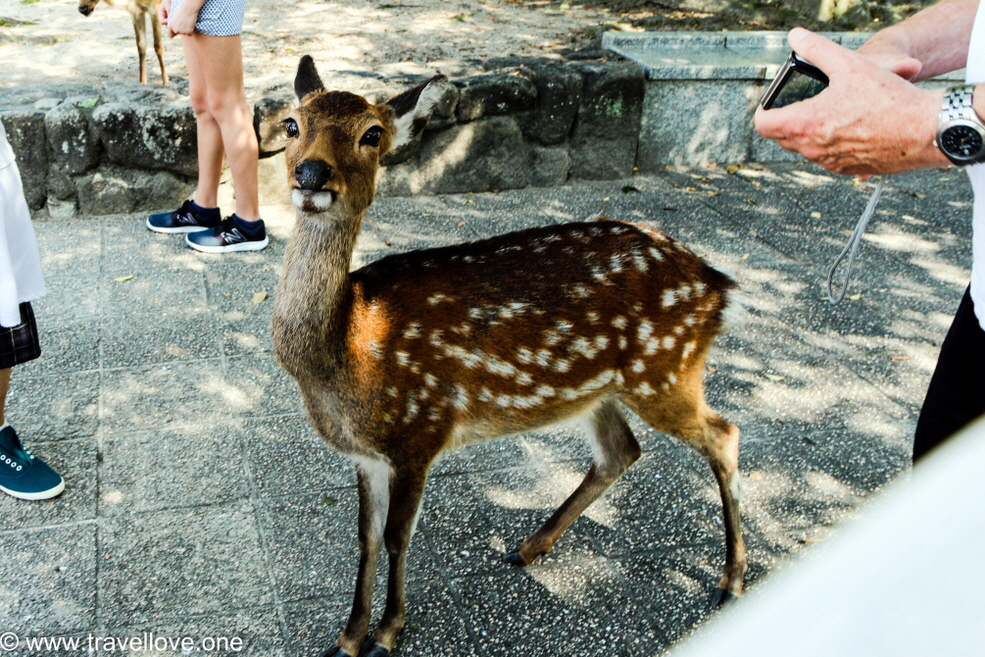
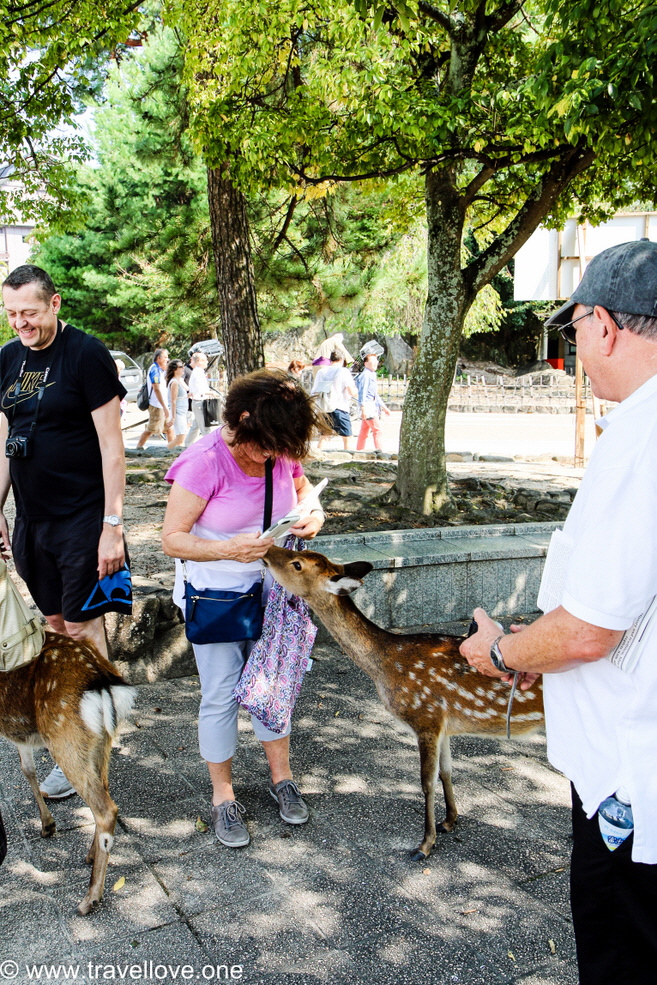
If you made the mistake of actually giving them something, you henceforth had a faithful but also very intrusive companion.
Hideo, completely immune to the charm of the deer, led us towards the torii.
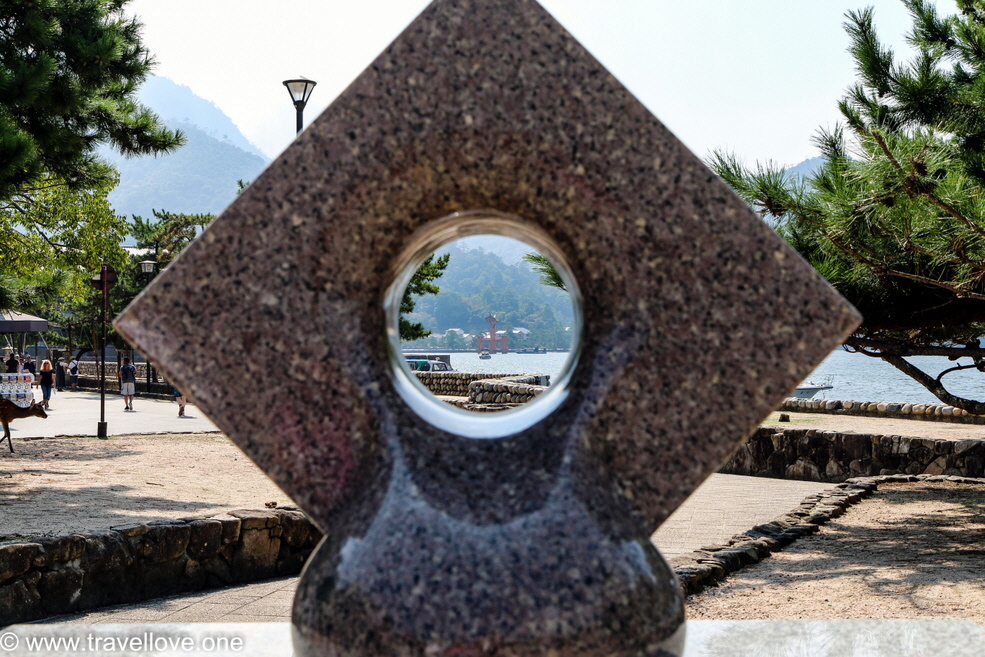
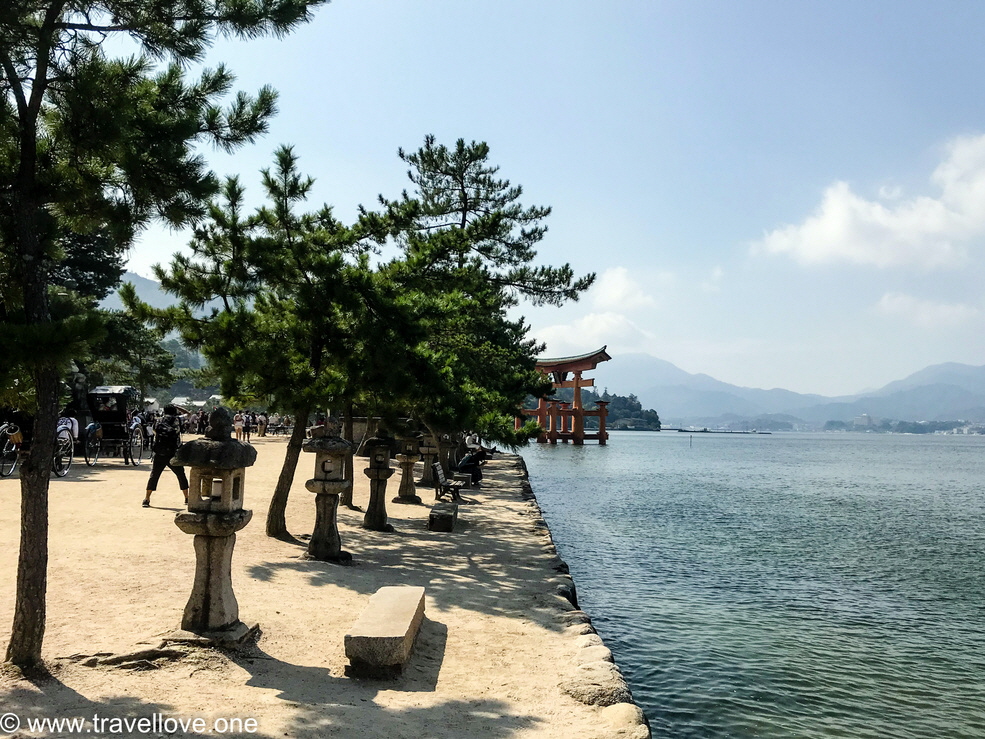
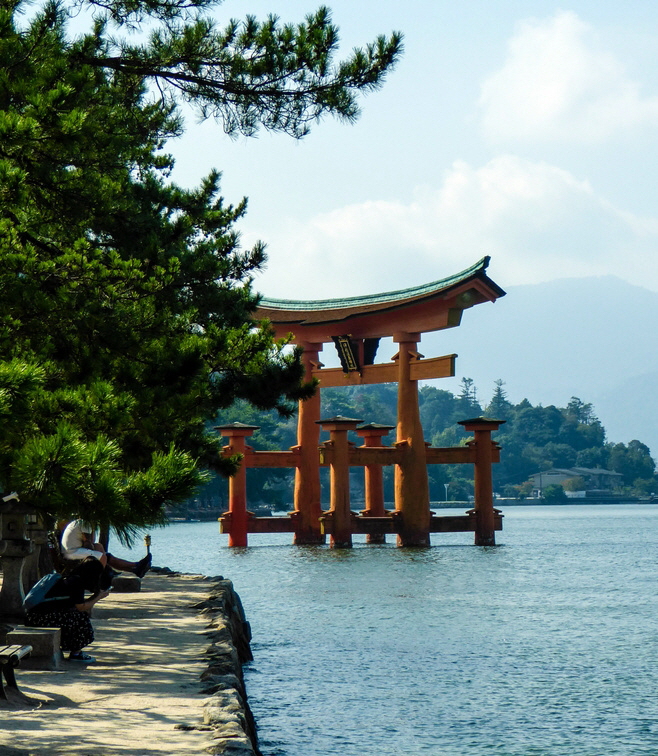
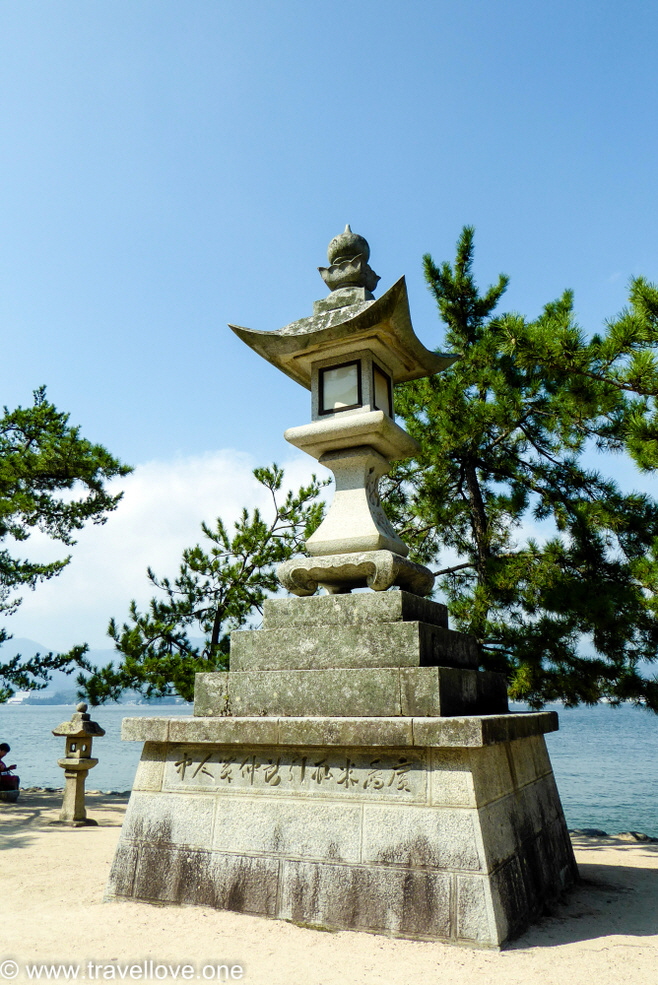
Along the way, small restaurants and food stalls offered one of Miyajima’s specialties, grilled oysters.
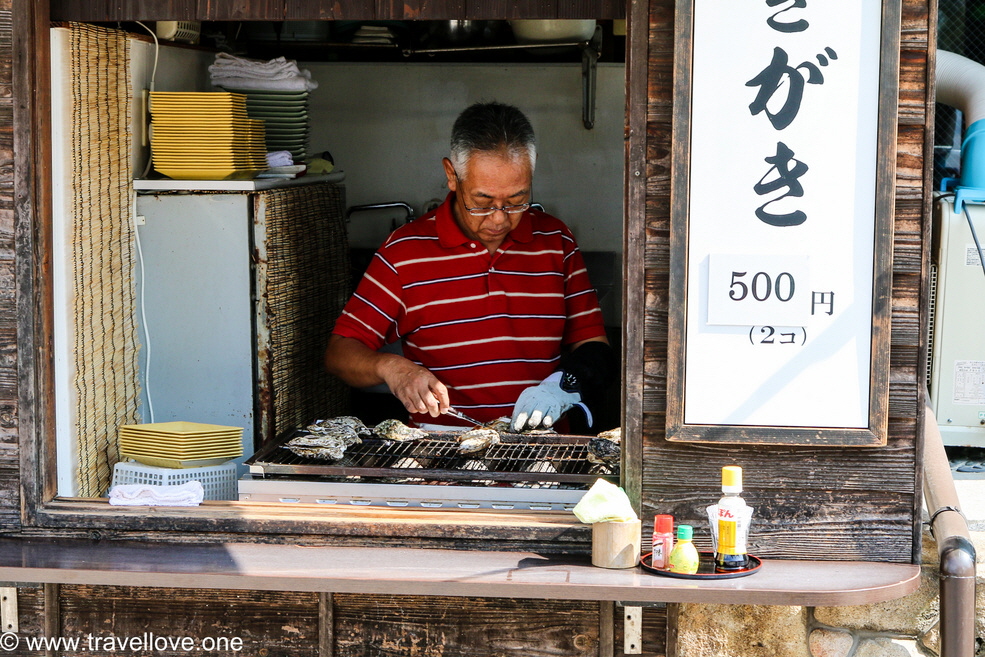
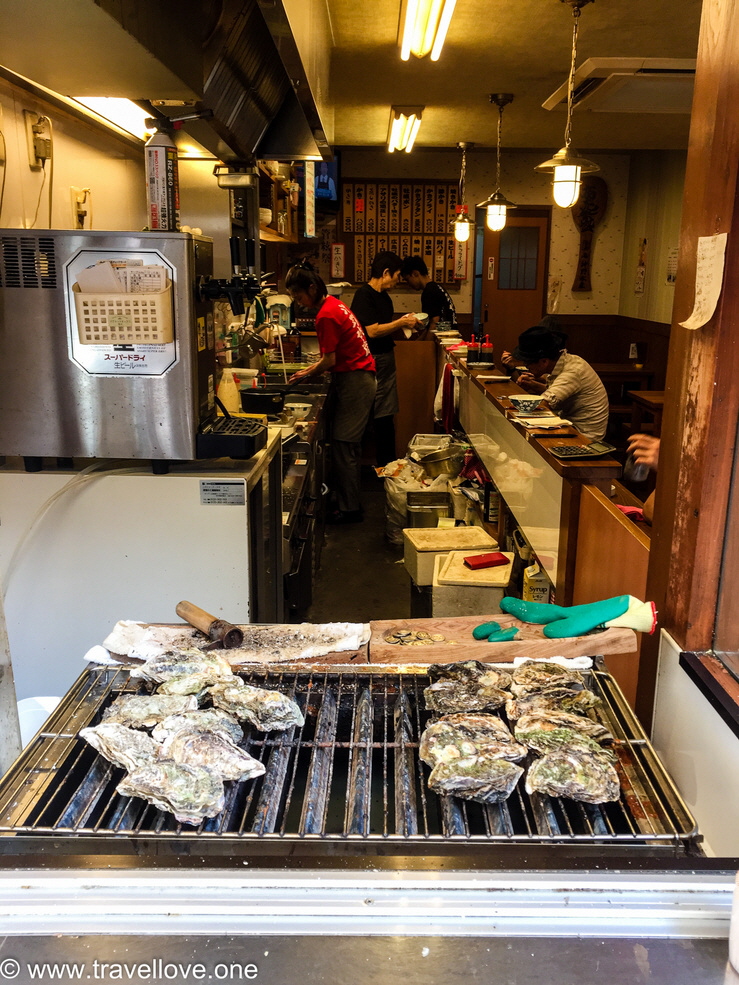
Soon we stood in front of the big red torii. It belongs to the rather rare type of six-legged ryōbu-torii. At high tide, the gate seems to float on the water and boats go out, whereas at low tide you can just walk up to it.
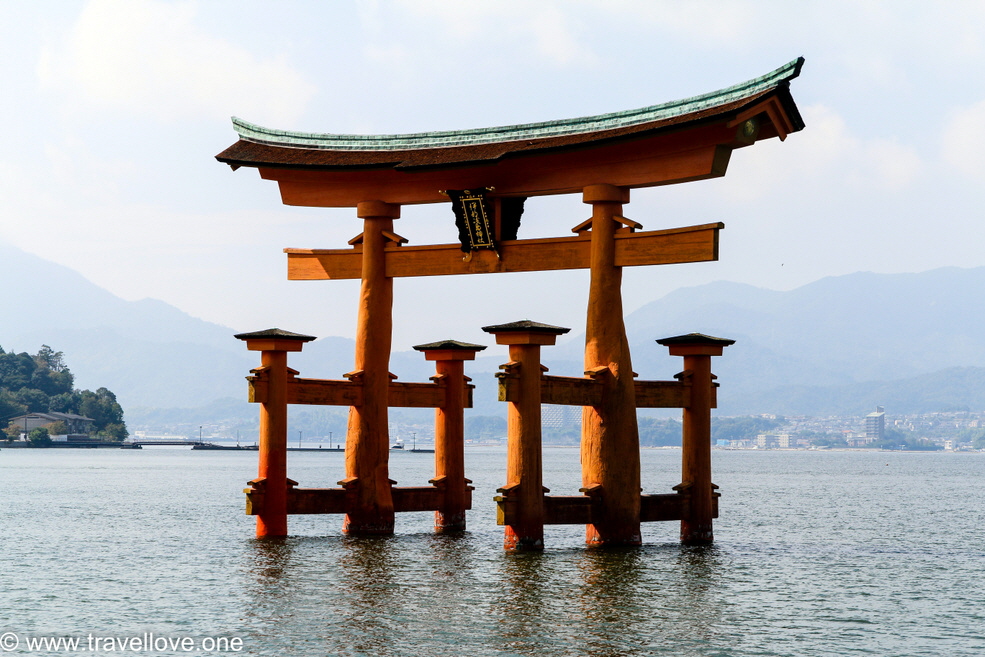
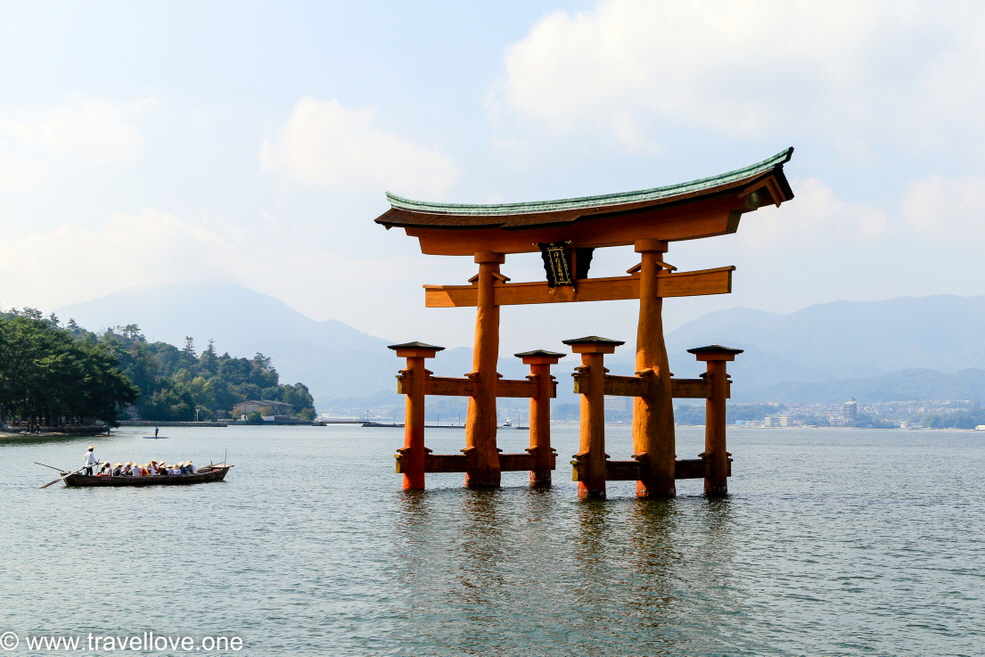
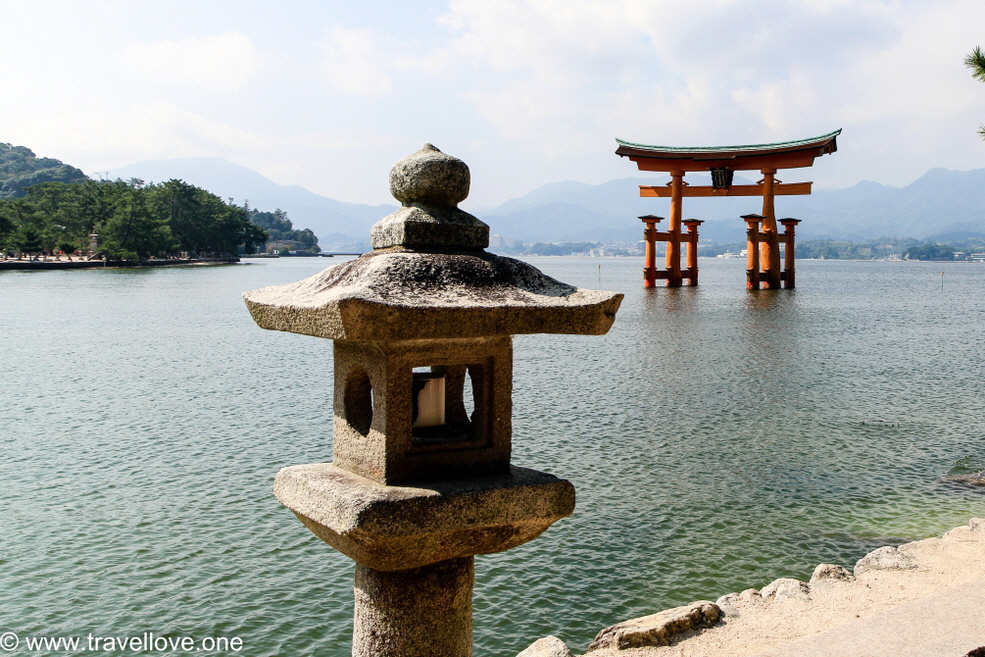
Of course, photos in front of the torii were mandatory…
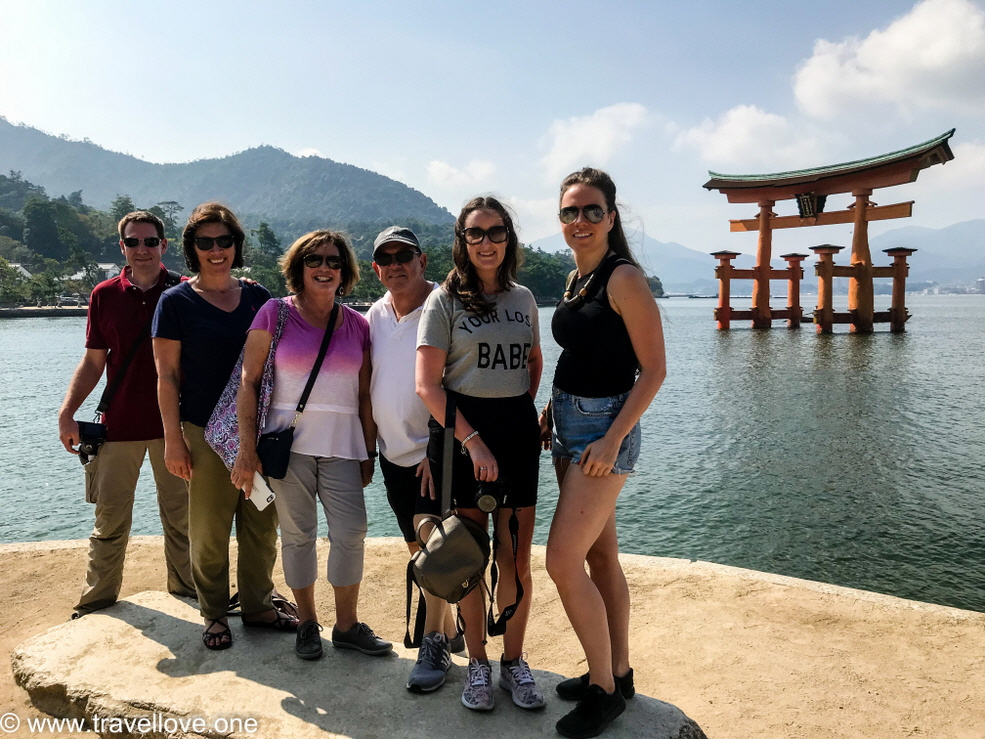
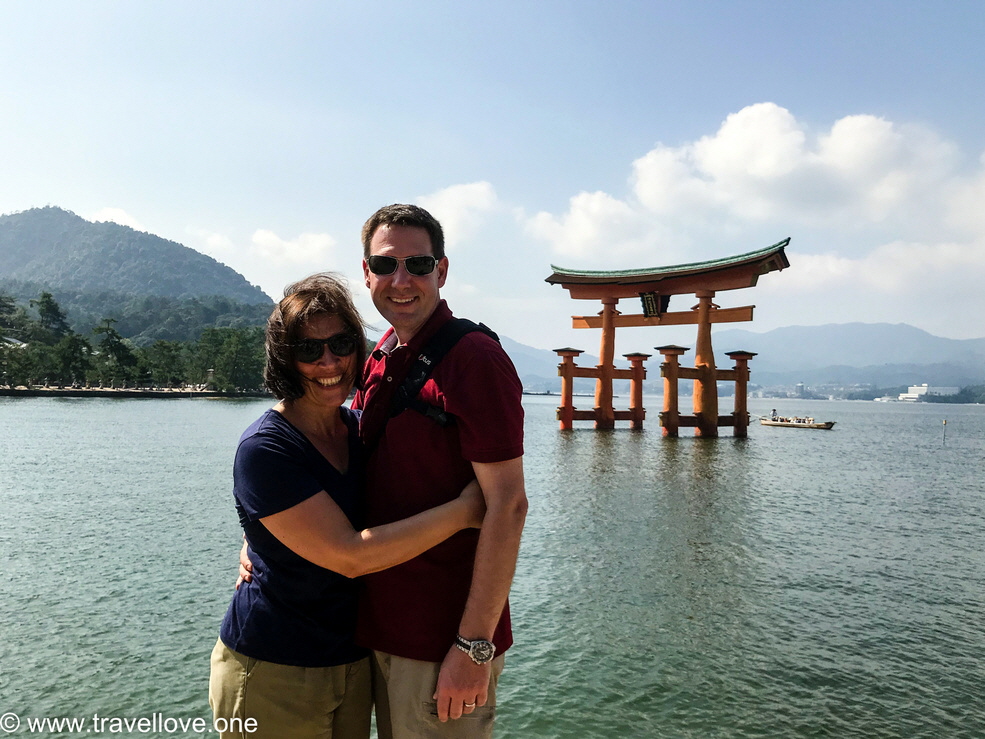
And we obviously had to take photos of these two little boys. They were visibly proud to compete with the torii and the deer as a photo attraction.
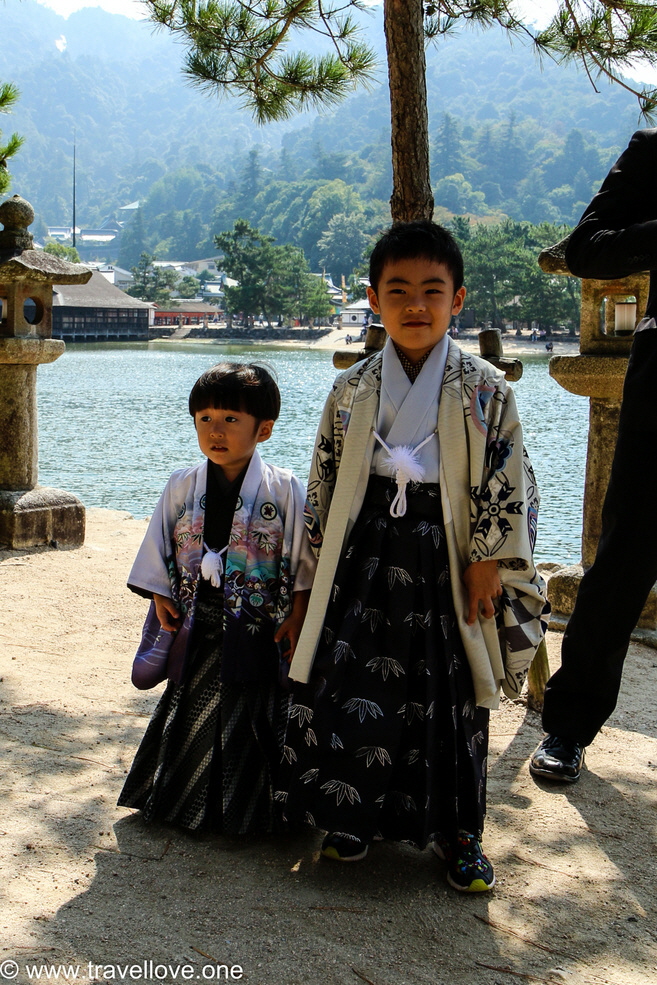
Instead of spending time with lunch, we decided to take a closer look at the Itsukushima shrine to which the torii belongs. We didn’t regret this decision. It is also due to the shrine that Miyajima is referred to as one of the three most beautiful places in Japan. Like the torii, the temple, painted in a fiery red, seemed to float on the water.
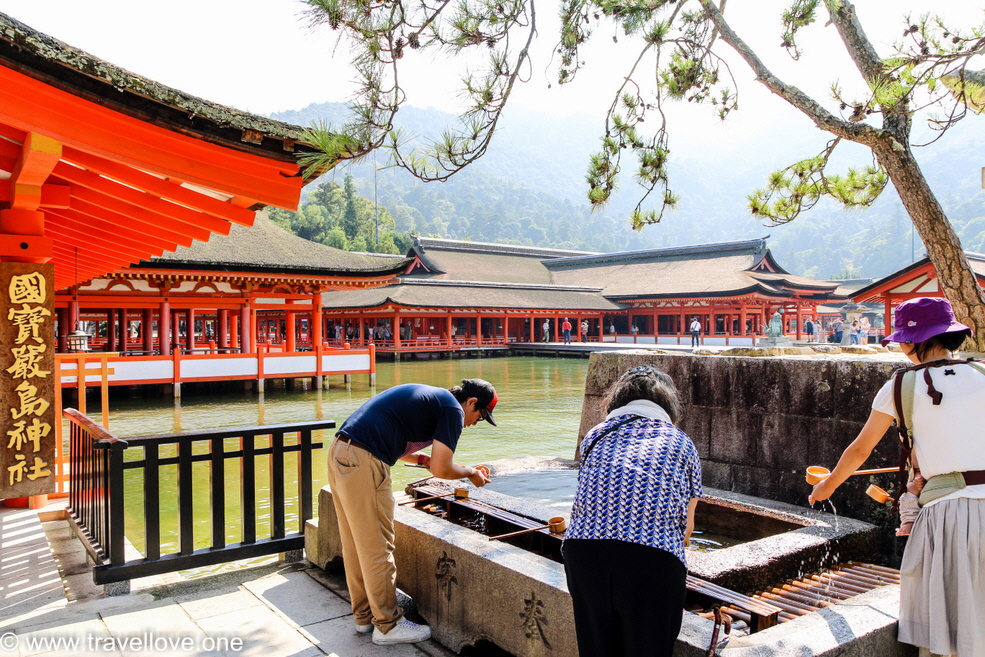
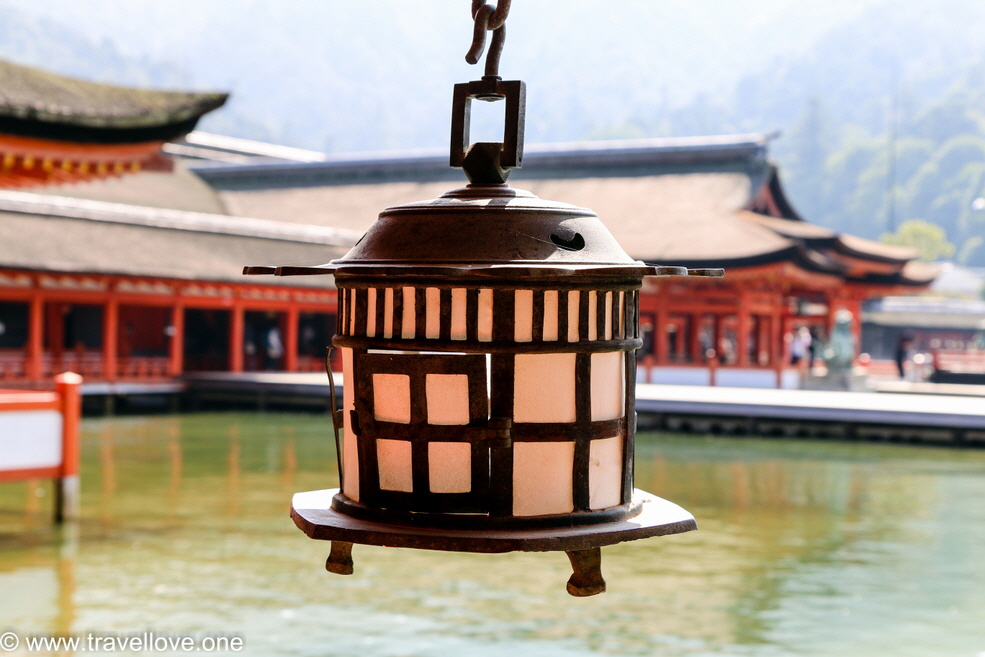
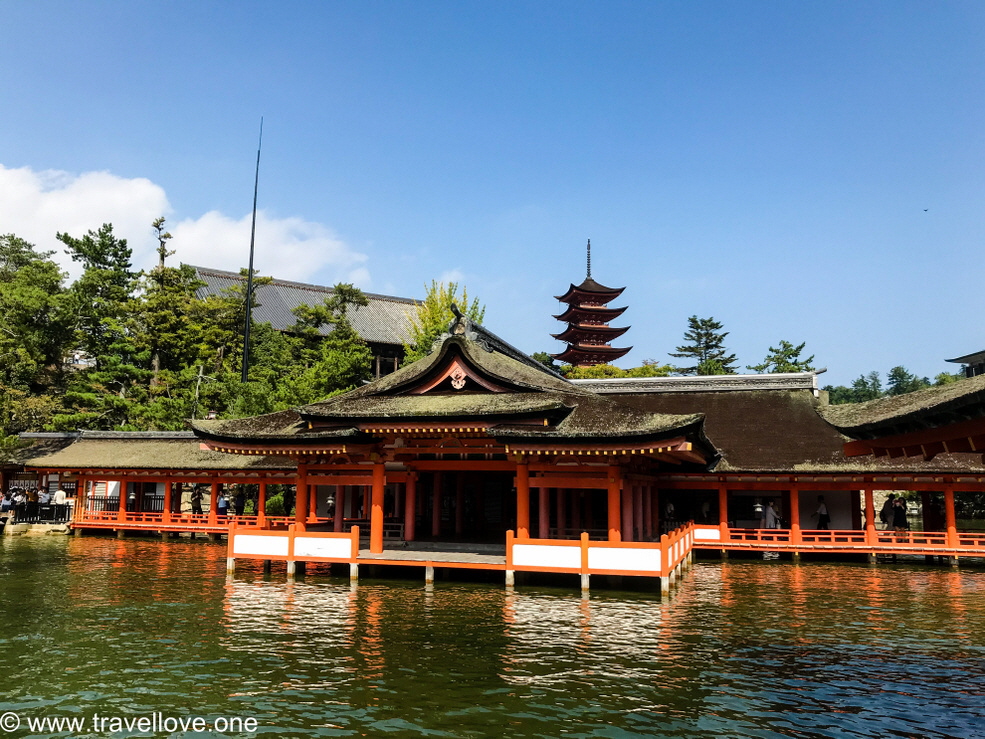
The main shrine of the complex, which was first mentioned in 811 AD, is dedicated to three Munakata goddesses: Ichikishima-hime, Tagitsu-hime und Tagori-hime.
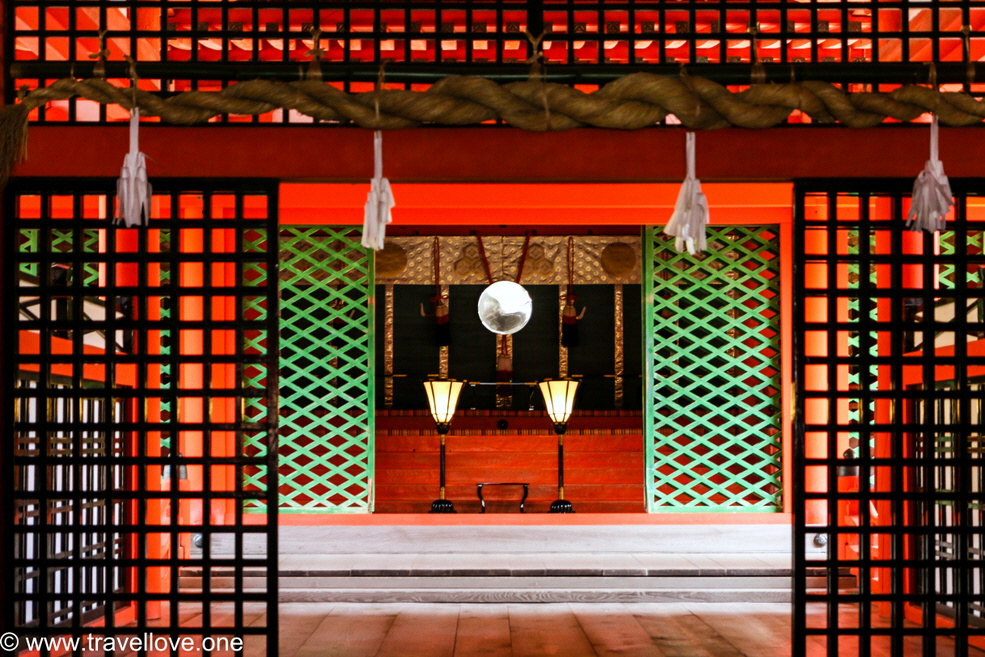
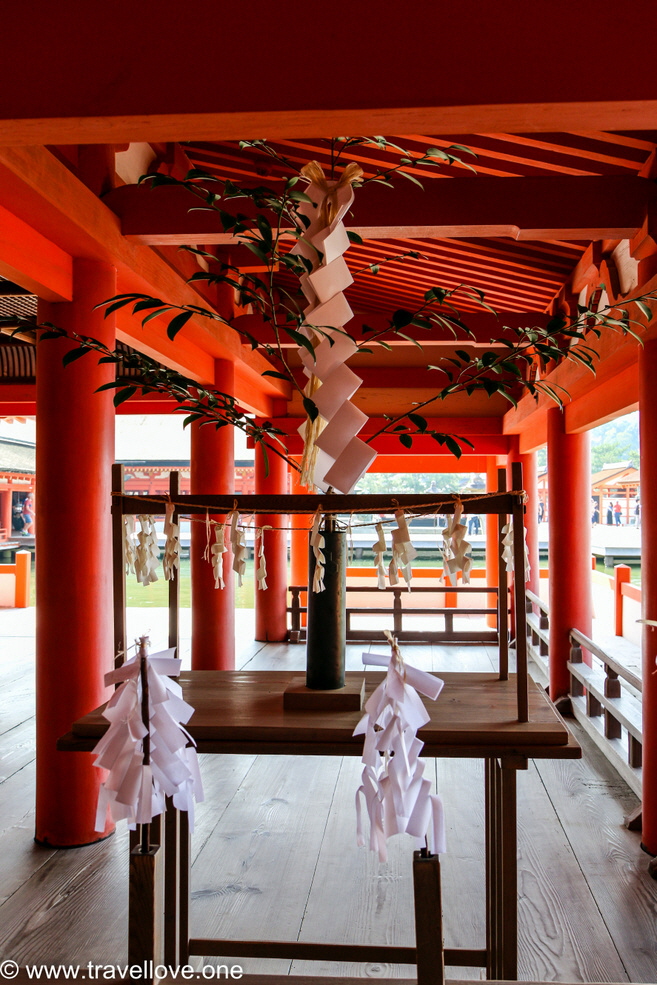
Hideo told us that the temple is beautifully lit by night. But we already found it extremely beautiful as it was and enjoyed the sight under the watchful eyes of stone guards.
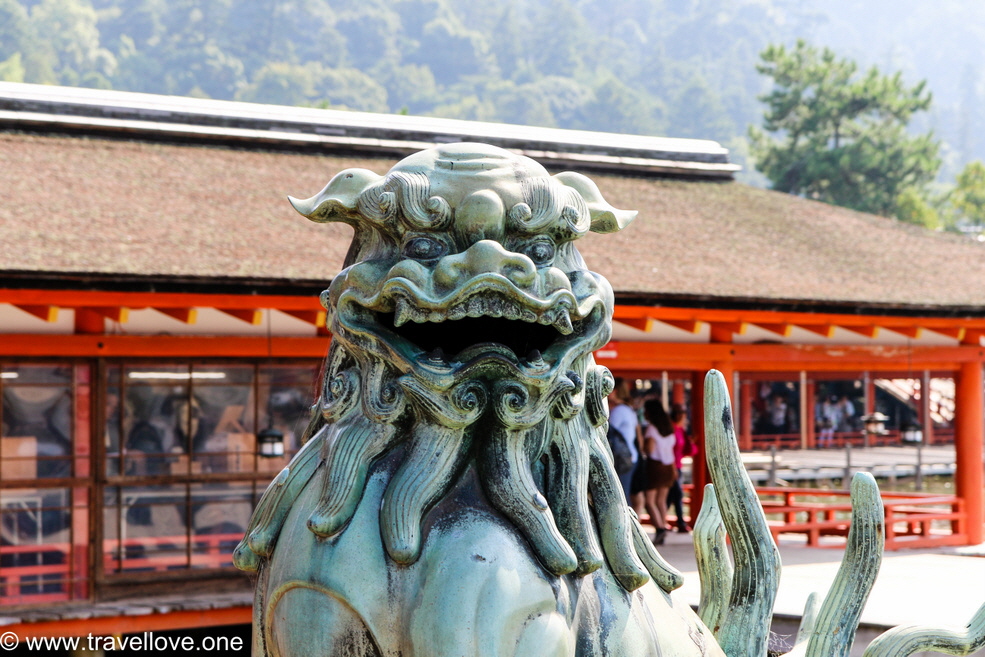
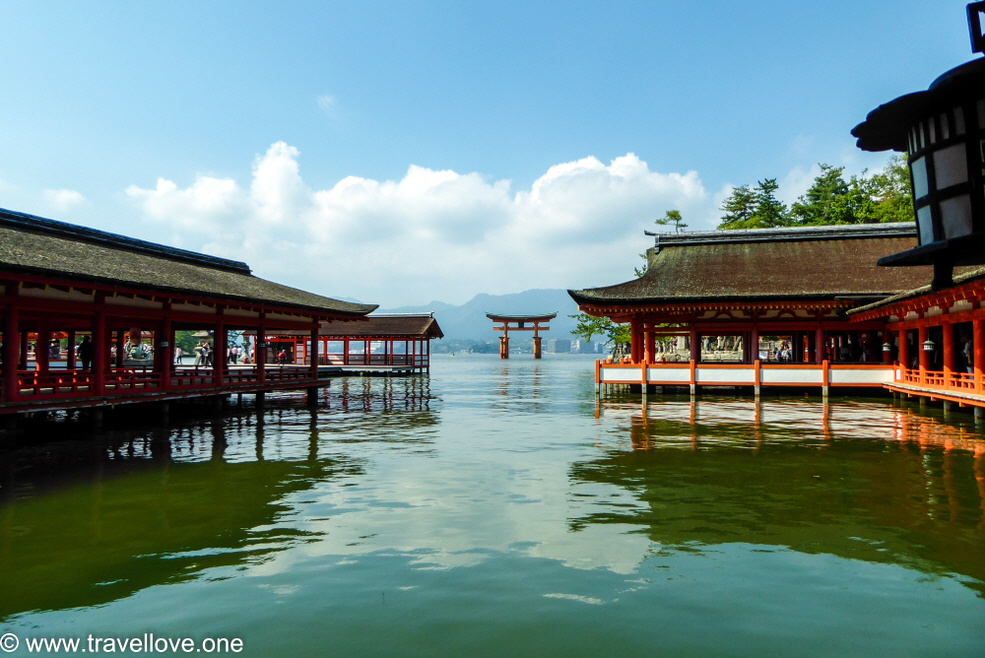
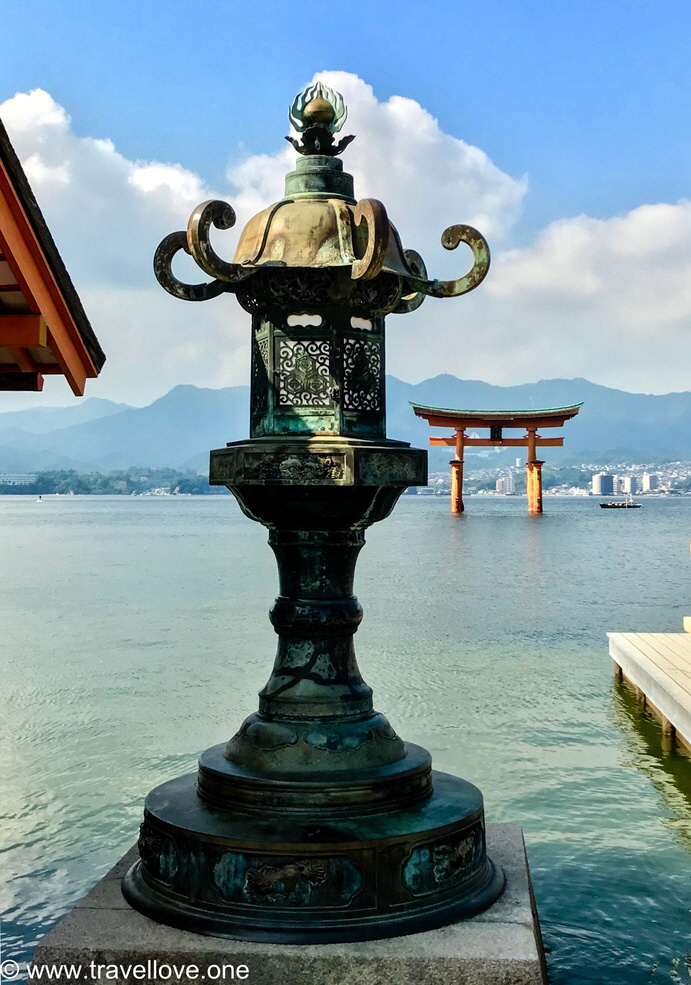
We passed the stage of a Noh theater, which was also built on stilts and the Sori-Bashi bridge which in itself is also listed as a national cultural treasure, and went to an exit on the other side of the shrine.
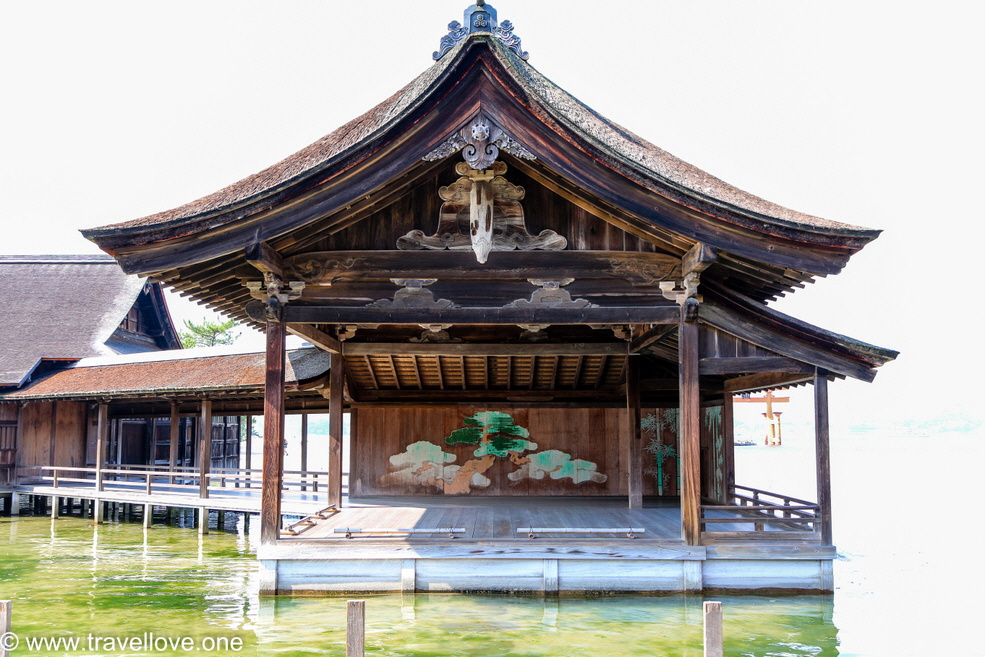
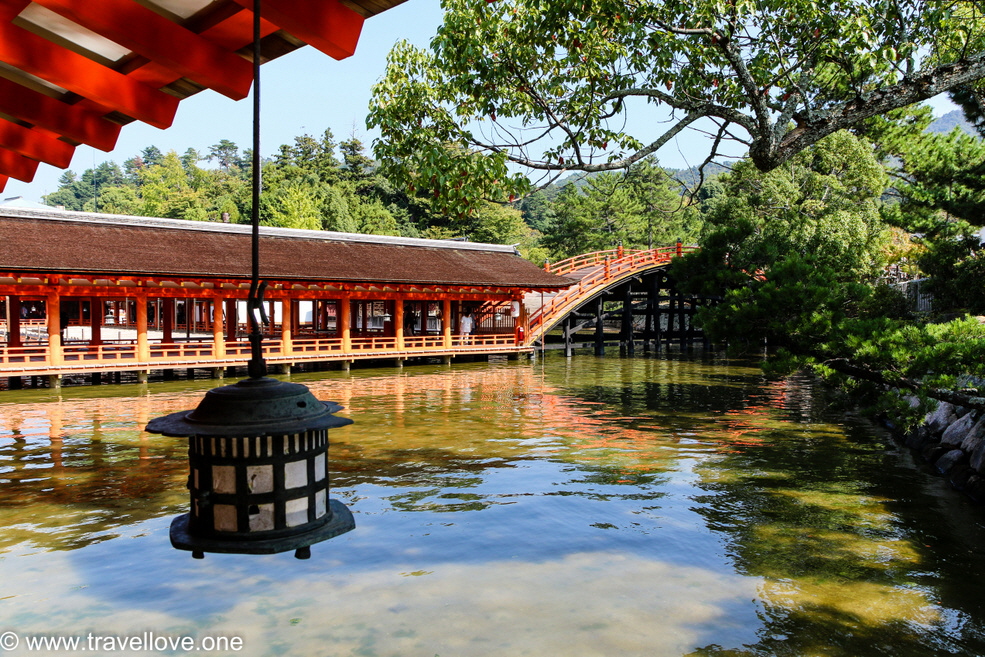
Following a little canal we rounded the shrine at the back where we found a stall selling deliciously fragrant skewers among the many shops. A worthy substitute for the lunch we had skipped.
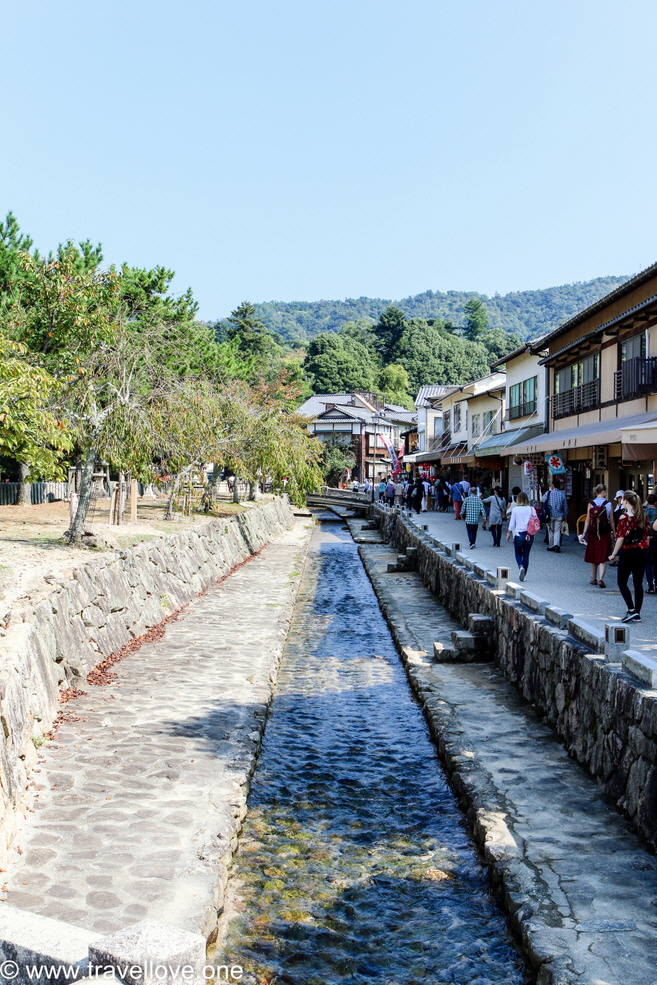
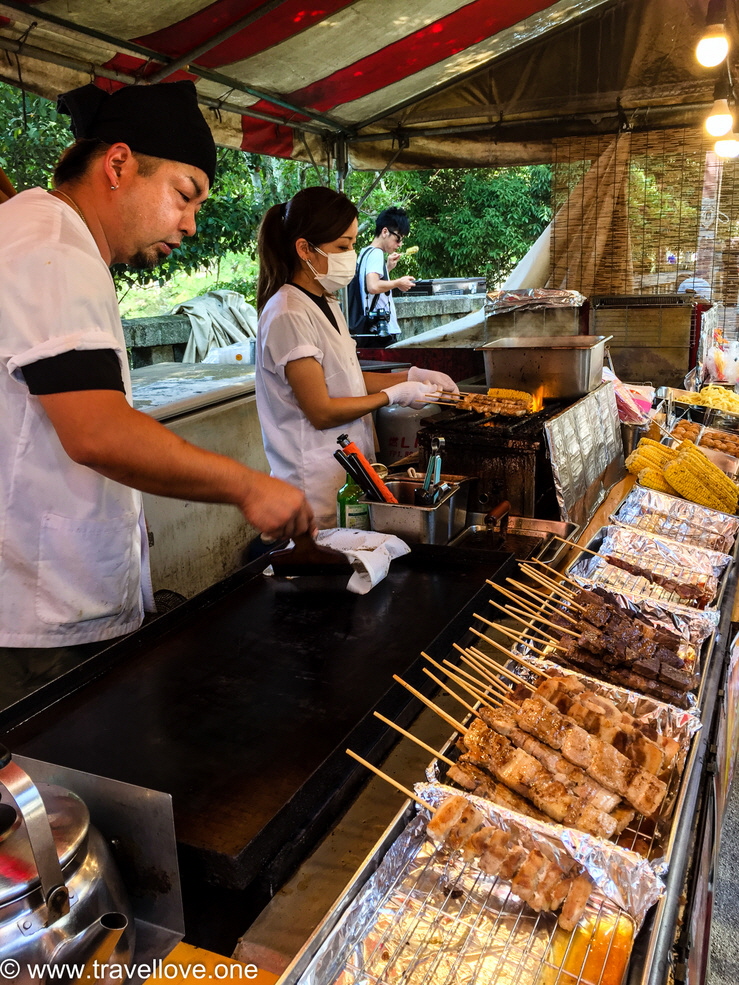
The deer seemed to approve of our choice and were right back on the scene. Frank had made a new friend in no time.
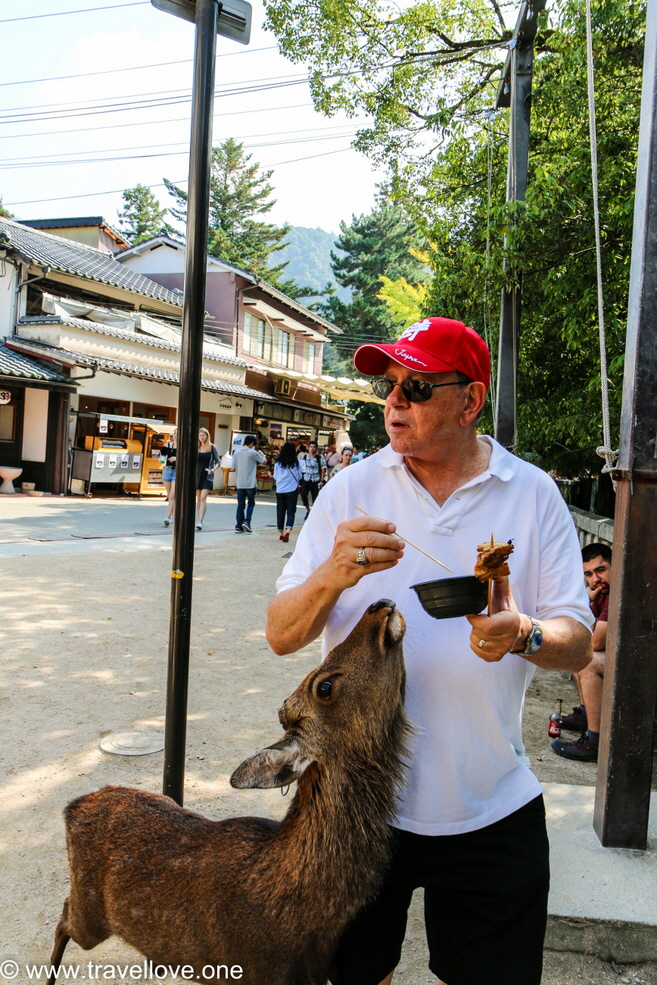
In the shopping street that took us back to the ferry dock, Momiji Manju, the local specialty, was offered in many shops: a filled pastry that was freshly made behind large shop windows. And of course anything matcha.
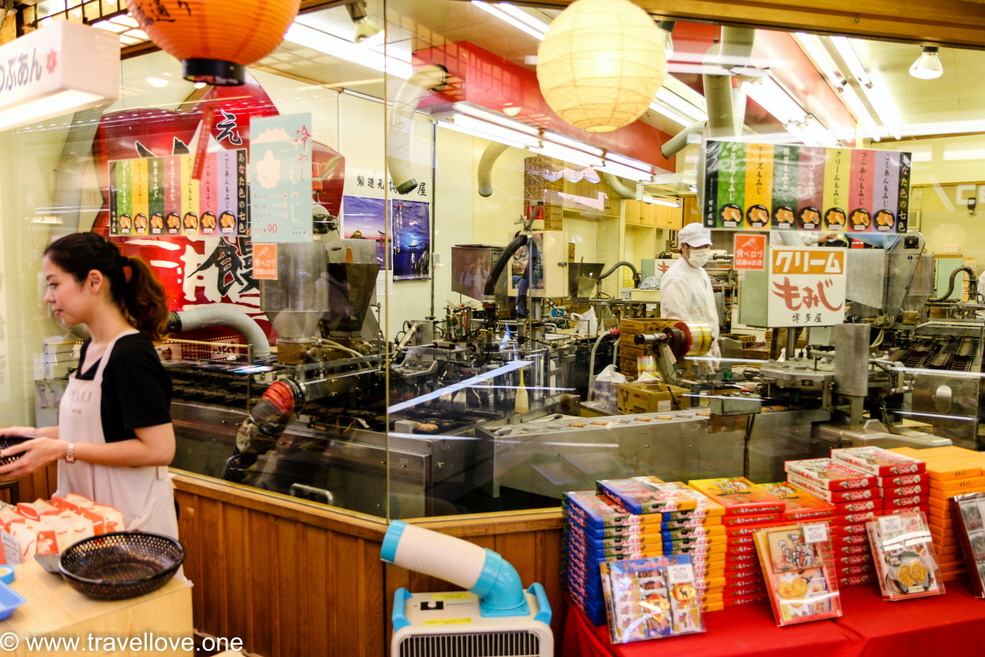
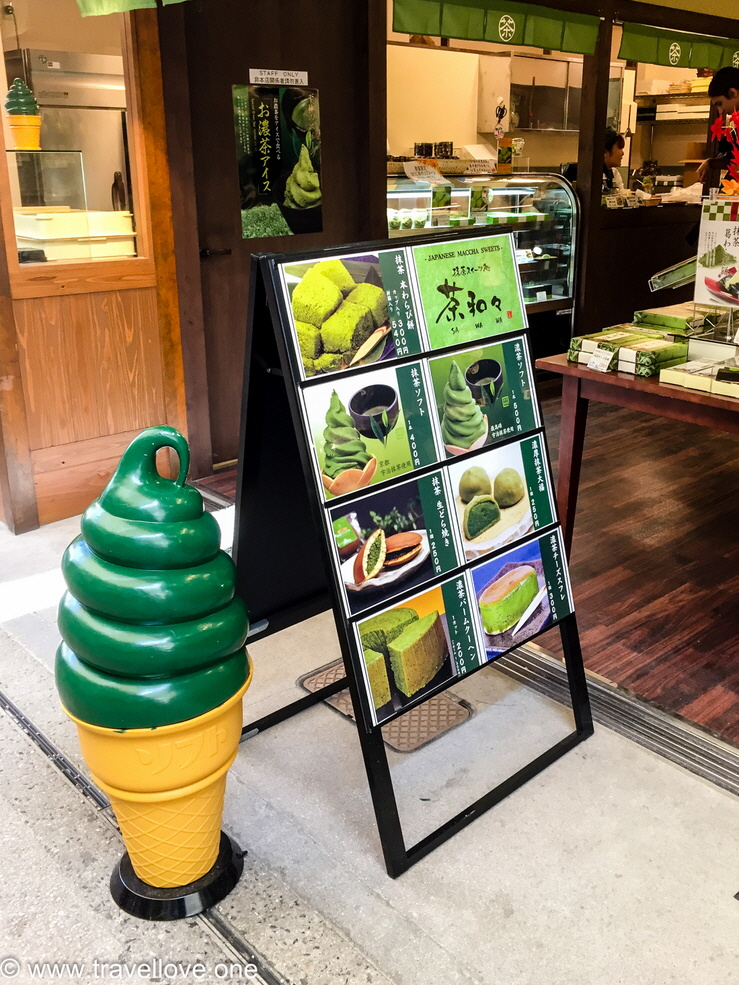
By ferry and train we returned to the ship. Together with Judy and Frank we enjoyed the sailaway at the Sunset Bar and talked until dinner about this day so rich in impressions. A day that had started on terrible images of horror and ended on images of tranquil beauty at the Miyajima Shrine.
As we watched the setting sun, we also shared our thoughts on Hiroshima. The open question from the lecture “Was the use of the nuclear bombs justified?“ also came up again. If at all, this question can probably only be answered in the context of the time. It is undisputed that the dropping of the nuclear bombs, which ultimately led to the surrender of Japan and thus to the end of a cruel war, spared hundreds or thousands of other human lives that would have fallen victim to a ground offensive. However, at the same time the old ethical question arises as to how many and whose lives may be sacrificed to spare others. I cannot answer this question for myself, but I have the strong wish and hope that we will never have to face it again.
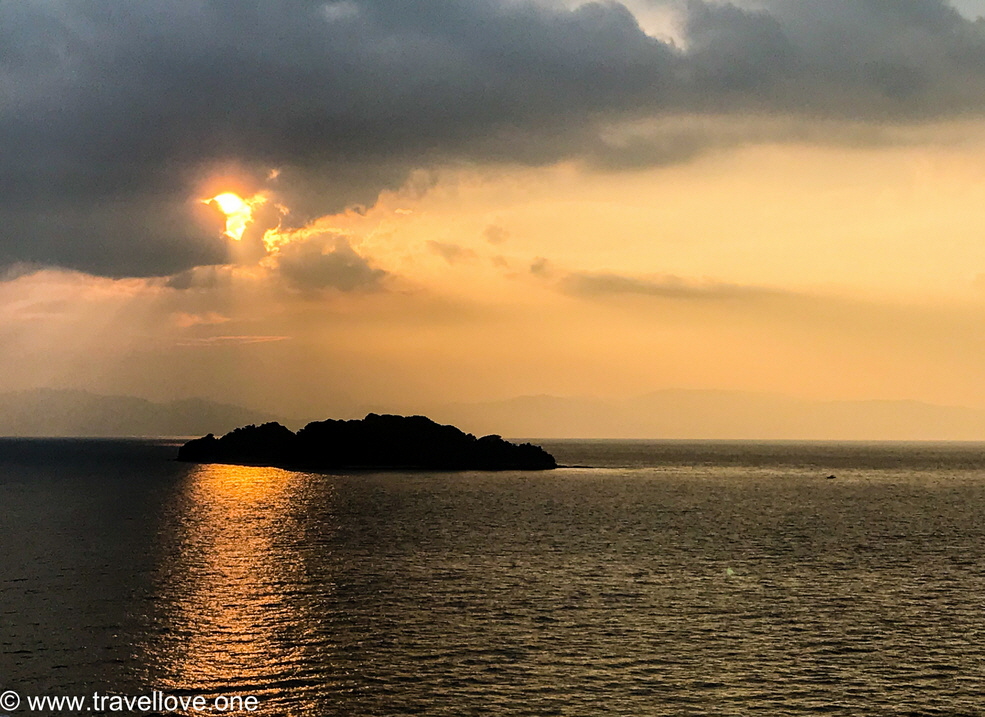
www.travellove.one • www.thecruise.report • www.travelandcruise.net
© 2021 Die Rechte an Texten, Fotos und Videos liegen beim Autor der Webseite. Die Nutzung ist nur nach ausdrücklicher Freigabe erlaubt.
